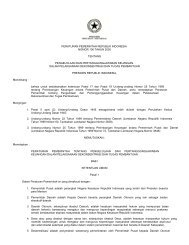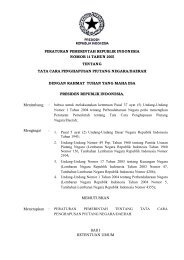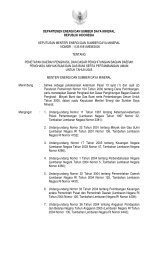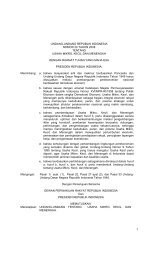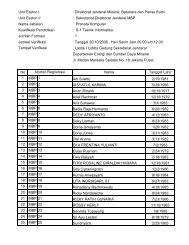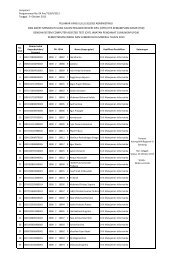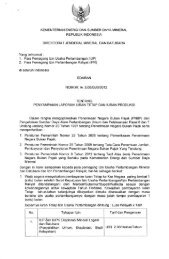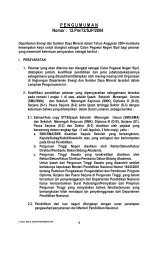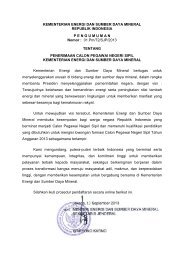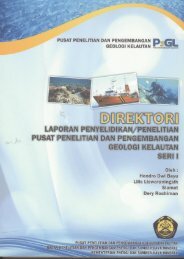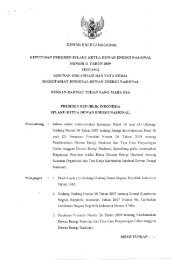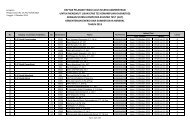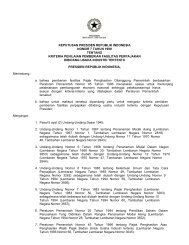Ignimbrite Analyses of Batur Caldera, Bali, based on 14C Dating
Ignimbrite Analyses of Batur Caldera, Bali, based on 14C Dating
Ignimbrite Analyses of Batur Caldera, Bali, based on 14C Dating
Create successful ePaper yourself
Turn your PDF publications into a flip-book with our unique Google optimized e-Paper software.
Jurnal Geologi Ind<strong>on</strong>esia, Vol. 4 No. 3 September 2009: 189-202<br />
<str<strong>on</strong>g>Ignimbrite</str<strong>on</strong>g> <str<strong>on</strong>g>Analyses</str<strong>on</strong>g> <str<strong>on</strong>g>of</str<strong>on</strong>g> <str<strong>on</strong>g>Batur</str<strong>on</strong>g> <str<strong>on</strong>g>Caldera</str<strong>on</strong>g>,<br />
<str<strong>on</strong>g>Bali</str<strong>on</strong>g>, <str<strong>on</strong>g>based</str<strong>on</strong>g> <strong>on</strong> 14 C <strong>Dating</strong><br />
Igan S. Sutawidjaja<br />
Centre for Volcanology and Geological Hazard Mitigati<strong>on</strong>, Geological Agency<br />
Jln. Dip<strong>on</strong>egoro 57, Bandung - 40122<br />
Abstract<br />
The <str<strong>on</strong>g>Batur</str<strong>on</strong>g> <str<strong>on</strong>g>Caldera</str<strong>on</strong>g>, in the northeastern part <str<strong>on</strong>g>of</str<strong>on</strong>g> <str<strong>on</strong>g>Bali</str<strong>on</strong>g> Island, is an elliptical collapse structure 13.8<br />
by 10 km in size and another circular composite collapse structure with a diameter <str<strong>on</strong>g>of</str<strong>on</strong>g> 7.5 km in its centre.<br />
Two stages <str<strong>on</strong>g>of</str<strong>on</strong>g> the collapse were interrupted by silicic andesite lavas and domes. The first collapse<br />
was initiated by the erupti<strong>on</strong> <str<strong>on</strong>g>of</str<strong>on</strong>g> about 84 km 3 <str<strong>on</strong>g>of</str<strong>on</strong>g> the dacitic "Ubud <str<strong>on</strong>g>Ignimbrite</str<strong>on</strong>g>", about 29,300 years B.P.,<br />
which caused a steep-walled depressi<strong>on</strong> about 1 km deep. The sec<strong>on</strong>d ignimbrite was erupted from<br />
a large crater about the present lake, and it produced about 19 km 3 <str<strong>on</strong>g>of</str<strong>on</strong>g> a similar voluminous dacitic<br />
ignimbrite, called the "Gunungkawi <str<strong>on</strong>g>Ignimbrite</str<strong>on</strong>g>" about 20,150 years B.P. This sec<strong>on</strong>d erupti<strong>on</strong> triggered<br />
a sec<strong>on</strong>d collapse, which created the central circular caldera, and formed a basin structure. Both<br />
the Ubud and Gunungkawi <str<strong>on</strong>g>Ignimbrite</str<strong>on</strong>g>s c<strong>on</strong>sist <str<strong>on</strong>g>of</str<strong>on</strong>g> a similar dacitic compositi<strong>on</strong>, white to red<br />
(the most abundant nearly 90 %) and dark grey to black dacitic pumice clasts. The large clasts, up<br />
to 20 cm in diameter, are in the n<strong>on</strong>-welded ignimbrite, particularly in the upper part <str<strong>on</strong>g>of</str<strong>on</strong>g> the Gunungkawi<br />
<str<strong>on</strong>g>Ignimbrite</str<strong>on</strong>g>. The intracaldera ignimbrite, called the "<str<strong>on</strong>g>Batur</str<strong>on</strong>g> <str<strong>on</strong>g>Ignimbrite</str<strong>on</strong>g>" about 5 km 3 in volume is a<br />
densely welded ignimbrite and generally shows typical welded features. The ignimbrite comprises<br />
at least five different flow units, separated by thin (15 - 40 cm) welded pumiceous airfall deposits, with<br />
flattened pumice clasts. Another large erupti<strong>on</strong> occurred about 5,500 years B.P., producing around<br />
0.09 km 3 andesitic ignimbrite. This was initiated by phreatomagmatic erupti<strong>on</strong>s, indicated by thick<br />
phreatomagmatic and surge deposits, underlying the ignimbrite. The caldera and its vicinity are partly<br />
filled, and variably mantled by later eruptive products <str<strong>on</strong>g>of</str<strong>on</strong>g> dacitic and andesitic phreatomagmatic<br />
and airfall deposits.<br />
Keywords: 14 C dating, ignimbrite, pumice clast, pyroclastic airfall deposit, dacite, phreatomagmatic<br />
Sari<br />
Kaldera <str<strong>on</strong>g>Batur</str<strong>on</strong>g> yang terletak di bagian timur laut Pulau <str<strong>on</strong>g>Bali</str<strong>on</strong>g>, merupakan sebuah struktur runtuhan berbentuk<br />
elips berukuran 13,8 x 10 km, dengan struktur runtuhan lainnya yang berbentuk melingkar di bagian<br />
pusatnya, dan berdiameter 7,5 km. Pembentukan kedua runtuhan tersebut diselingi oleh erupsi lava andesit<br />
silikaan dan pembentukan kubah-kubah lava andesitis. Runtuhan pertama yang terjadi sekitar 29.300 tahun<br />
lalu, diawali oleh erupsi 84 km 3 ignimbrit dasit, disebut “Ignimbrit Ubud” dan menyebabkan terbentuknya<br />
depresi sedalam 1 km. Ignimbrit kedua, yang disebut sebagai “Ignimbrit Gunungkawi”, dierupsikan melalui<br />
sebuah kawah besar sekitar danau sekarang, dan memuntahkan 19 km 3 ignimbrit dasit yang sama pada<br />
20.150 tahun lalu. Erupsi kedua ini memicu terbentuknya runtuhan di bagian pusat, dan membentuk sebuah<br />
cekungan. Ignimbrit Ubud dan Gunungkawi tersebut terdiri atas komposisi dasit yang sama, berwarna putih<br />
hingga merah (jumlah paling banyak mencapai 90 %), dengan butiran batuapung dasitis berwarna abu-abu<br />
tua hingga hitam. Butiran besar yang mencapai diameter lebih dari 20 cm terdapat pada ignimbrit tidak<br />
terlaskan, terutama di bagian atas Ignimbrit Gunungkawi. Ignimbrit di bagian dalam kaldera, yang disebut<br />
“Ignimbrit <str<strong>on</strong>g>Batur</str<strong>on</strong>g>” dengan volume sekitar 5 km 3 berupa ignimbrit terlaskan dan umumnya memperlihatkan<br />
struktur pengelasan khas yang sekurang-kurangnya terdiri atas lima unit aliran berbeda, masing-masing<br />
diselingi endapan jatuhan batuapung terlaskan dengan lensa-lensa batuapung. Erupsi besar lainnya terjadi<br />
Naskah diterima: 24 April 2009, revisi kesatu: 22 Mei 2009, revisi kedua: 08 Juli 2009, revisi terakhir: 3 Agustus 2009<br />
189
190 Jurnal Geologi Ind<strong>on</strong>esia, Vol. 4 No. 3 September 2009: 189-202<br />
pada 5.500 tahun lalu yang memuntahkan sekitar 0,09 km 3 ignimbrit andesitis. Erupsi ini diawali oleh erupsi<br />
freatomagmatik yang ditunjukkan oleh endapan tebal material freatomagmatik dan endapan seruak, yang<br />
menindih ignimbrit. Kaldera dan sekitarnya terisi sebagian dan terselimuti oleh hasil erupsi kemudian yang<br />
berupa endapan freatomagmatik dan jatuhan andesitis.<br />
Kata kunci: penarikkan 14 C, ignimbrit, butiran batuapung, jatuhan piroklastik, dasit, freatomagmatik<br />
Introducti<strong>on</strong><br />
<str<strong>on</strong>g>Batur</str<strong>on</strong>g> caldera is situated in the northeastern<br />
part <str<strong>on</strong>g>of</str<strong>on</strong>g> <str<strong>on</strong>g>Bali</str<strong>on</strong>g> Island, and about 70 km north <str<strong>on</strong>g>of</str<strong>on</strong>g> the<br />
capital city <str<strong>on</strong>g>of</str<strong>on</strong>g> <str<strong>on</strong>g>Bali</str<strong>on</strong>g>, Denpasar. The area <str<strong>on</strong>g>of</str<strong>on</strong>g> investigati<strong>on</strong>,<br />
located <strong>on</strong> the eastern part <str<strong>on</strong>g>of</str<strong>on</strong>g> <str<strong>on</strong>g>Bali</str<strong>on</strong>g> Island<br />
is bounded by latitudes 8 0 05'00" - 8 0 40'00" S, and<br />
l<strong>on</strong>gitudes 115 0 11'00" - 115°30'00" E (Figure 1). The<br />
area includes 2,300 km 2 <str<strong>on</strong>g>of</str<strong>on</strong>g> which the major part is<br />
gently sloping to the south and steeply sloping to<br />
the north. There are six main routes <str<strong>on</strong>g>of</str<strong>on</strong>g> travel to the<br />
caldera that can be attained from Denpasar and <strong>on</strong>e<br />
route from Singaraja. The most useable <str<strong>on</strong>g>of</str<strong>on</strong>g> these<br />
is the road from Denpasar to Kintamani passing<br />
Bangli town. The <str<strong>on</strong>g>Batur</str<strong>on</strong>g> <str<strong>on</strong>g>Caldera</str<strong>on</strong>g> is <strong>on</strong>e <str<strong>on</strong>g>of</str<strong>on</strong>g> the finest<br />
calderas in the world, about 13.8 by 10 km in size<br />
(Bemmelen, 1961) and another circular composite<br />
collapsed structure with a diameter <str<strong>on</strong>g>of</str<strong>on</strong>g> 7.5 km formed<br />
in its centre. The rim varies in height from 1267<br />
to 2152 m (the marginal c<strong>on</strong>e <str<strong>on</strong>g>of</str<strong>on</strong>g> Mount Abang).<br />
Within the caldera, there is the active stratovolcano<br />
<str<strong>on</strong>g>of</str<strong>on</strong>g> <str<strong>on</strong>g>Batur</str<strong>on</strong>g> Volcano and a lake. The highest peak <str<strong>on</strong>g>of</str<strong>on</strong>g><br />
<str<strong>on</strong>g>Batur</str<strong>on</strong>g> Volcano is about 1717 m above sea level and<br />
686 m above the surface <str<strong>on</strong>g>of</str<strong>on</strong>g> Lake <str<strong>on</strong>g>Batur</str<strong>on</strong>g>, and it is<br />
located at 8°14'30" S and 115 0 22'30" E (Neumann<br />
van Padang, 1951; Kusumadinata, 1979). According<br />
to Kemmerling (1917), the presence <str<strong>on</strong>g>of</str<strong>on</strong>g> Mount<br />
Sukawana and Abang volcanic remnants indicate<br />
that the previous stratovolcano <str<strong>on</strong>g>of</str<strong>on</strong>g> Mount <str<strong>on</strong>g>Batur</str<strong>on</strong>g> was<br />
higher than Mount Agung (3142 m), and the present<br />
caldera complex was produced by a collapse <str<strong>on</strong>g>of</str<strong>on</strong>g> the<br />
old stratovolcano.<br />
The young stratovolcano <str<strong>on</strong>g>of</str<strong>on</strong>g> <str<strong>on</strong>g>Batur</str<strong>on</strong>g> has erupted<br />
at least 22 times since the 1800's, generally with<br />
FLORES SEA<br />
N<br />
8 0 00’<br />
BUYAN-BRATAN<br />
CALDERA<br />
BATUR CALDERA<br />
0 5 10 km<br />
8 0 15’<br />
BALI STRAIT<br />
MT. AGUNG<br />
MT. SERAYA<br />
8 0 30’<br />
BALI ISLAND<br />
BADUNG STRAIT<br />
8 0 45’<br />
INDIAN OCEAN<br />
NUSA PENIDA ISLAND<br />
114 0 15’<br />
114 0 30’<br />
114 0 45’<br />
115 0 00’<br />
115 0 15’<br />
115 0 30’<br />
9 0 00’<br />
115 0 45’<br />
Figure 1. Index map <str<strong>on</strong>g>of</str<strong>on</strong>g> the <str<strong>on</strong>g>Batur</str<strong>on</strong>g> <str<strong>on</strong>g>Caldera</str<strong>on</strong>g> in <str<strong>on</strong>g>Bali</str<strong>on</strong>g> Island.
<str<strong>on</strong>g>Ignimbrite</str<strong>on</strong>g> <str<strong>on</strong>g>Analyses</str<strong>on</strong>g> <str<strong>on</strong>g>of</str<strong>on</strong>g> <str<strong>on</strong>g>Batur</str<strong>on</strong>g> <str<strong>on</strong>g>Caldera</str<strong>on</strong>g>, <str<strong>on</strong>g>Bali</str<strong>on</strong>g>, <str<strong>on</strong>g>based</str<strong>on</strong>g> <strong>on</strong> 14 C <strong>Dating</strong> (I.S. Sutawidjaja)<br />
191<br />
strombolian erupti<strong>on</strong>s and lava flows. The last<br />
erupti<strong>on</strong> <strong>on</strong> March, 1974 (Samud,1968), led to<br />
basaltic andesite lapilli and lava to flow deposit. A<br />
large erupti<strong>on</strong> occurred <strong>on</strong> September 5th, 1963 to<br />
May 10th, 1964, mostly lava flows covering a total<br />
area <str<strong>on</strong>g>of</str<strong>on</strong>g> about 5,779,000 m 2 in three separate places<br />
(Kusumadinata, 1964).<br />
Tect<strong>on</strong>ic setting<br />
The Indian - Australian Plate c<strong>on</strong>verges northward<br />
into the Southeast Asia Plate as indicated by<br />
the magnetic anomalies (Sclater and Fisher, 1974).<br />
Oceanic lithosphere subducts with perpendicular<br />
incidence beneath the predominantly estimatic island<br />
arc <str<strong>on</strong>g>of</str<strong>on</strong>g> Jawa.<br />
The Ind<strong>on</strong>esian volcanic arc extends for 6,000<br />
km from northern Sumatra to the Maluku Sea<br />
(Hutchis<strong>on</strong>, 1981). It c<strong>on</strong>sists <str<strong>on</strong>g>of</str<strong>on</strong>g> four volcanic belts.<br />
The l<strong>on</strong>gest volcanic arc is Sunda Belt, extending<br />
from the northern tip <str<strong>on</strong>g>of</str<strong>on</strong>g> Sumatra throughout Jawa,<br />
<str<strong>on</strong>g>Bali</str<strong>on</strong>g>, Lombok, Sumbawa, and Flores. The other<br />
three belts are Banda, Halmahera, and North Sulawesi<br />
(Katili, 1973; Hamilt<strong>on</strong>, 1979). Al<strong>on</strong>g the<br />
6,000 km volcanic island arc there are 500 erupti<strong>on</strong><br />
centres, 129 <str<strong>on</strong>g>of</str<strong>on</strong>g> which are regarded to be active during<br />
the present time (Padang, 1951; Kusumadinata,<br />
1979). They represent more than 13 % <str<strong>on</strong>g>of</str<strong>on</strong>g> active<br />
volcanoes <str<strong>on</strong>g>of</str<strong>on</strong>g> the world. Within the Sunda, Banda,<br />
Halmahera, and Minahasa volcanic arcs, there are<br />
95, 9, 7, 18 active volcanoes, respectively. In Sumatra<br />
and western Jawa, volcanism may have been<br />
occurring since Triassic times, but in the eastern<br />
part <str<strong>on</strong>g>of</str<strong>on</strong>g> the arc it seems to have begun <strong>on</strong>ly in the<br />
Middle to Late Miocene (Hamilt<strong>on</strong>, 1979). The<br />
c<strong>on</strong>tinental crust in the Sumatra and Jawa areas<br />
is 20 to 30 km thick, through the intermediatetype<br />
crust near <str<strong>on</strong>g>Bali</str<strong>on</strong>g> and Lombok to the oceanic<br />
crust near Wetar and the Banda Islands. The crust<br />
beneath <str<strong>on</strong>g>Bali</str<strong>on</strong>g> Island is about 18 km thick and has<br />
seismic velocities similar to those <str<strong>on</strong>g>of</str<strong>on</strong>g> oceanic crust<br />
(Curray et al., 1977). The depth <str<strong>on</strong>g>of</str<strong>on</strong>g> the Beni<str<strong>on</strong>g>of</str<strong>on</strong>g>f<br />
Z<strong>on</strong>e beneath the <str<strong>on</strong>g>Batur</str<strong>on</strong>g> Volcano is 165 km, which<br />
has been computed by multiple linear regressi<strong>on</strong><br />
analyses (Hutchis<strong>on</strong>, 1976). Hutchis<strong>on</strong> deduced<br />
that an eastwards decrease <str<strong>on</strong>g>of</str<strong>on</strong>g> 87 Sr/ 86 Sr from 0.706<br />
to 0.704 from west Jawa to <str<strong>on</strong>g>Bali</str<strong>on</strong>g> suggests a transiti<strong>on</strong><br />
from a c<strong>on</strong>tinental to an oceanic basement.<br />
The depth <str<strong>on</strong>g>of</str<strong>on</strong>g> the seismic z<strong>on</strong>e beneath the arc<br />
reaches to approximately 650 km depth between<br />
Jawa and Flores.<br />
Regi<strong>on</strong>al Geology<br />
In Jawa and <str<strong>on</strong>g>Bali</str<strong>on</strong>g>, the oldest widely exposed<br />
rocks are lower Tertiary shallow marine sediments,<br />
which are intruded and overlain by plut<strong>on</strong>ic and<br />
related volcanic rocks in a z<strong>on</strong>e <strong>on</strong>ly slightly south<br />
<str<strong>on</strong>g>of</str<strong>on</strong>g> the present-day volcanic arc (Bemmelen, 1949).<br />
The igneous activity corresp<strong>on</strong>ds to Bemmelen's<br />
(1949) first cycle <str<strong>on</strong>g>of</str<strong>on</strong>g> volcanism and gave rise to the<br />
"Old-Andesites", which were relatively comm<strong>on</strong> in<br />
the Southern Mountains <str<strong>on</strong>g>of</str<strong>on</strong>g> Jawa and in the Barisan<br />
Range <str<strong>on</strong>g>of</str<strong>on</strong>g> Sumatra, and it culminated in a period <str<strong>on</strong>g>of</str<strong>on</strong>g><br />
uplift and intrusi<strong>on</strong> in the Mid-Miocene. Bemmelen<br />
(1949) recognized a sec<strong>on</strong>d cycle <str<strong>on</strong>g>of</str<strong>on</strong>g> volcanism<br />
<str<strong>on</strong>g>of</str<strong>on</strong>g> Late Tertiary age marked by the appearance <str<strong>on</strong>g>of</str<strong>on</strong>g><br />
more alkaline lavas such as those <str<strong>on</strong>g>of</str<strong>on</strong>g> the high-K<br />
calc-alkaline suite. This sec<strong>on</strong>d cycle was located<br />
further north and north east from the Miocene "Old-<br />
Andesites". These rocks are found together with the<br />
Quaternary "third cycle <str<strong>on</strong>g>of</str<strong>on</strong>g> volcanism", and the distincti<strong>on</strong><br />
between the products <str<strong>on</strong>g>of</str<strong>on</strong>g> these latter cycles<br />
is rarely clear-cut.<br />
The rocks <str<strong>on</strong>g>of</str<strong>on</strong>g> the Sumatra to <str<strong>on</strong>g>Bali</str<strong>on</strong>g> sector have<br />
a spectrum from tholeiitic through calc-alkaline<br />
to high-K calc-alkaline series. There is an apparent<br />
eastwards decrease <str<strong>on</strong>g>of</str<strong>on</strong>g> 87 Sr/ 86 Sr from 0.7059 to<br />
0.7038 from West Jawa to <str<strong>on</strong>g>Bali</str<strong>on</strong>g> (Whitford, 1975).<br />
There is also some evidences <str<strong>on</strong>g>of</str<strong>on</strong>g> the ratio increase<br />
in Beni<str<strong>on</strong>g>of</str<strong>on</strong>g>f Z<strong>on</strong>e depth from about 0.7040 at 130<br />
km to 0.7050 at 200 km, over the range tholeiitic<br />
to high-K calc-alkaline series (Hutchis<strong>on</strong>, 1981). In<br />
1976, Hutchis<strong>on</strong> determined that the <str<strong>on</strong>g>Bali</str<strong>on</strong>g> volcano<br />
<str<strong>on</strong>g>of</str<strong>on</strong>g> <str<strong>on</strong>g>Batur</str<strong>on</strong>g> bel<strong>on</strong>gs to the high-alumina series, with<br />
average Al 2<br />
0 3<br />
values at around 20 wt.%, whereas<br />
most Ind<strong>on</strong>esian volcanoes range between 15 to 17<br />
%. This has resulted in a normative deficiency <str<strong>on</strong>g>of</str<strong>on</strong>g><br />
diopside, as the norm calculati<strong>on</strong> allocated the Ca to<br />
Al and Si to overproduce anorthite, whereas in nature<br />
the Al c<strong>on</strong>tent will also be in the clinopyroxene and<br />
hornblende.<br />
The <str<strong>on</strong>g>Batur</str<strong>on</strong>g> volcanic field, which covers about<br />
2,300 km 2 in the eastern part <str<strong>on</strong>g>of</str<strong>on</strong>g> <str<strong>on</strong>g>Bali</str<strong>on</strong>g> Island <str<strong>on</strong>g>of</str<strong>on</strong>g><br />
Ind<strong>on</strong>esia, has a large, well formed caldera which<br />
formati<strong>on</strong> is correlated with the erupti<strong>on</strong>s about
192 Jurnal Geologi Ind<strong>on</strong>esia, Vol. 4 No. 3 September 2009: 189-202<br />
29,300 years B.P. and 20,150 years B.P. <str<strong>on</strong>g>of</str<strong>on</strong>g> thick<br />
ignimbrite sheets. About 29,300 years B.P., the major<br />
volcanic activity changed to explosive pyroclastic<br />
flow erupti<strong>on</strong>s <str<strong>on</strong>g>of</str<strong>on</strong>g> dacitic compositi<strong>on</strong> that persisted<br />
until the sec<strong>on</strong>d ash-flow erupti<strong>on</strong> about 20,150<br />
years B.P. Two separate ignimbrite sheets have<br />
been recognized; the source areas for these are correlated<br />
to the caldera formati<strong>on</strong>s <str<strong>on</strong>g>of</str<strong>on</strong>g> <str<strong>on</strong>g>Batur</str<strong>on</strong>g>. Basaltic<br />
to basaltic andesite lavas and pyroclastic deposits<br />
are interlayered with and underlie the ignimbrite<br />
sequences, particularly in the southern slope <str<strong>on</strong>g>of</str<strong>on</strong>g> the<br />
caldera. Other more mafic lavas that are distinguishable<br />
lithologically from the pre-caldera volcanic<br />
rocks are recognized as pillow basalts.<br />
Stratigraphy Of <str<strong>on</strong>g>Bali</str<strong>on</strong>g> Island<br />
The basic stratigraphy <str<strong>on</strong>g>of</str<strong>on</strong>g> <str<strong>on</strong>g>Bali</str<strong>on</strong>g> and adjacent<br />
islands as previously understood was largely established<br />
by Purbo-Hadiwidjojo (1971) (Figure 2). The<br />
oldest rocks exposed in <str<strong>on</strong>g>Bali</str<strong>on</strong>g> are the Ulakan Formati<strong>on</strong><br />
<str<strong>on</strong>g>of</str<strong>on</strong>g> Lower Miocene age, as volcanic rocks comprising<br />
lavas, breccias and tuffs with intercalati<strong>on</strong>s <str<strong>on</strong>g>of</str<strong>on</strong>g><br />
calcareous sandst<strong>on</strong>es, but Kadar (1972) determined<br />
the oldest rock units in <str<strong>on</strong>g>Bali</str<strong>on</strong>g> are calcareous sandst<strong>on</strong>es<br />
<str<strong>on</strong>g>of</str<strong>on</strong>g> Late Miocene age. As described by Wheller<br />
and Varne (1986), the oldest <str<strong>on</strong>g>Bali</str<strong>on</strong>g> volcanic rocks are<br />
pillow basalts <str<strong>on</strong>g>of</str<strong>on</strong>g> Late Pliocene age. The southern<br />
part <str<strong>on</strong>g>of</str<strong>on</strong>g> <str<strong>on</strong>g>Bali</str<strong>on</strong>g> and Nusa Penida Islands are formed <str<strong>on</strong>g>of</str<strong>on</strong>g><br />
uplifted coral reefs <str<strong>on</strong>g>of</str<strong>on</strong>g> Pliocene to Pleistocene age<br />
(Kadar, 1977). The basement rocks <str<strong>on</strong>g>of</str<strong>on</strong>g> the mapped<br />
area c<strong>on</strong>sist <str<strong>on</strong>g>of</str<strong>on</strong>g> pillow basalts and pumiceous tephras,<br />
which are exposed in the southern part <str<strong>on</strong>g>of</str<strong>on</strong>g> the caldera<br />
in the vicinity <str<strong>on</strong>g>of</str<strong>on</strong>g> Bangli. Purbo-Hadiwidjojo (1971)<br />
described that both rock units are included in the<br />
Ulakan Formati<strong>on</strong>. Most <str<strong>on</strong>g>of</str<strong>on</strong>g> the island is composed <str<strong>on</strong>g>of</str<strong>on</strong>g><br />
subaerial volcanic deposits which were erupted from<br />
the extinct Quaternary Bratan, Batukau, and Seraya<br />
Volcanoes, and the two active volcanoes <str<strong>on</strong>g>Batur</str<strong>on</strong>g> and<br />
Agung (Purbo-Hadiwidjojo, 1971).<br />
The Bratan and <str<strong>on</strong>g>Batur</str<strong>on</strong>g> volcanic products <str<strong>on</strong>g>of</str<strong>on</strong>g><br />
several kinds make up a large proporti<strong>on</strong> <str<strong>on</strong>g>of</str<strong>on</strong>g> the<br />
rock over the island <str<strong>on</strong>g>of</str<strong>on</strong>g> <str<strong>on</strong>g>Bali</str<strong>on</strong>g>. There is no separati<strong>on</strong><br />
between Bratan and <str<strong>on</strong>g>Batur</str<strong>on</strong>g> caldera products. In this<br />
case, the author attempted to separate these volcanic<br />
products by petrographical and chemical analyses,<br />
and material behavior in the field. The rocks mainly<br />
F L O R E S S E A<br />
8 0 00’<br />
N<br />
0 5 10 km<br />
8 0 15’<br />
Alluvial deposit<br />
Volcanic Products <str<strong>on</strong>g>of</str<strong>on</strong>g> Mt. Pohen, Mt. Sengayang, Mt. Les<strong>on</strong>g<br />
Lavas <str<strong>on</strong>g>of</str<strong>on</strong>g> Paw<strong>on</strong> Parasitic C<strong>on</strong>e<br />
Volcanic products <str<strong>on</strong>g>of</str<strong>on</strong>g> Mt. Batukau<br />
QUATERNARY<br />
Volcanic products <str<strong>on</strong>g>of</str<strong>on</strong>g> Mt. Agung<br />
Volcanic products <str<strong>on</strong>g>of</str<strong>on</strong>g> present Mt. <str<strong>on</strong>g>Batur</str<strong>on</strong>g><br />
Buyan-Bratan and <str<strong>on</strong>g>Batur</str<strong>on</strong>g> Tuffs and Lahar Deposits<br />
PALASARI FORMATION<br />
C<strong>on</strong>glomerates, sandst<strong>on</strong>es, reef - limest<strong>on</strong>es<br />
SERAYA VOLCANICS<br />
EARLY<br />
Volcanics <str<strong>on</strong>g>of</str<strong>on</strong>g> Old Buyan-Bratan and <str<strong>on</strong>g>Batur</str<strong>on</strong>g> volcanoes<br />
QUATERNARY<br />
JEMBRANA VOLCANICS<br />
Lavas, breccias, tuffs<br />
ASAH FORMATION<br />
Lavas, breccias, pumiceous tuffs with calcareous crack fillings<br />
PRAPATAGUNG FORMATION<br />
Limest<strong>on</strong>es, calcareous sandst<strong>on</strong>es, marls<br />
PLIOCENE<br />
PULAKI VOLCANICS<br />
Lavas and breccias<br />
SELATAN FORMATION<br />
Predominantly limest<strong>on</strong>es<br />
MIO-PLIOCENE<br />
SORGA FORMATION<br />
Tuffs, marls, sandst<strong>on</strong>es<br />
MIDDLE MIOCENE<br />
ULAKAN FORMATION<br />
Volcanic breccias, lavas, tuffs with intercalati<strong>on</strong> <str<strong>on</strong>g>of</str<strong>on</strong>g> calcareous materials<br />
EARLY MIOCENE<br />
B A L I<br />
BADUNG STRAIT<br />
NUSA PENIDAS IS.<br />
I N D I A N O C E A N<br />
8 0 30’<br />
8 0 45’<br />
9 0 00’<br />
114 0 15’<br />
114 0 30’<br />
114 0 45’<br />
115 0 00’<br />
115 0 15’<br />
115 0 30’<br />
115 0 45’<br />
Figure 2. Geologic map <str<strong>on</strong>g>of</str<strong>on</strong>g> <str<strong>on</strong>g>Bali</str<strong>on</strong>g> Island (after Purbo-Hadiwidjojo, 1971).
<str<strong>on</strong>g>Ignimbrite</str<strong>on</strong>g> <str<strong>on</strong>g>Analyses</str<strong>on</strong>g> <str<strong>on</strong>g>of</str<strong>on</strong>g> <str<strong>on</strong>g>Batur</str<strong>on</strong>g> <str<strong>on</strong>g>Caldera</str<strong>on</strong>g>, <str<strong>on</strong>g>Bali</str<strong>on</strong>g>, <str<strong>on</strong>g>based</str<strong>on</strong>g> <strong>on</strong> 14 C <strong>Dating</strong> (I.S. Sutawidjaja)<br />
193<br />
c<strong>on</strong>sisting <str<strong>on</strong>g>of</str<strong>on</strong>g> ash-flow deposits (ignimbrite) with<br />
some are welded, overlies the sedimentary and older<br />
volcanic rocks. Some <str<strong>on</strong>g>of</str<strong>on</strong>g> the volcanic rocks erupted<br />
from Mount Pohen, Sengayang and Les<strong>on</strong>g, occupy<br />
the area in the centre <str<strong>on</strong>g>of</str<strong>on</strong>g> the island, particularly<br />
basaltic andesitic lavas and tephras. Volcanologists<br />
who have examined the <str<strong>on</strong>g>Batur</str<strong>on</strong>g> <str<strong>on</strong>g>Caldera</str<strong>on</strong>g> and areas<br />
elsewhere, largely the ignimbrites, have questi<strong>on</strong>ed<br />
aspects <str<strong>on</strong>g>of</str<strong>on</strong>g> the locally established sequence. Marinelli<br />
and Tazieff (1968) believed that the paroxysm<br />
phase <str<strong>on</strong>g>of</str<strong>on</strong>g> the <str<strong>on</strong>g>Batur</str<strong>on</strong>g> <str<strong>on</strong>g>Caldera</str<strong>on</strong>g> formati<strong>on</strong> occurred<br />
22,000 years ago, producing rhyodacitic ignimbrite.<br />
Moreover the <str<strong>on</strong>g>Caldera</str<strong>on</strong>g> II culminated in the major<br />
ignimbrite erupti<strong>on</strong> about 23,700 years ago were<br />
followed by periodic strombolian erupti<strong>on</strong>s <str<strong>on</strong>g>of</str<strong>on</strong>g> the<br />
basaltic magma.<br />
Reinvestigati<strong>on</strong> in 2006 <str<strong>on</strong>g>of</str<strong>on</strong>g> the <str<strong>on</strong>g>Batur</str<strong>on</strong>g> <str<strong>on</strong>g>Caldera</str<strong>on</strong>g><br />
area, resulted that major revisi<strong>on</strong>s are required in<br />
the previously used stratigraphy. Corroboratory evidence<br />
has come from 14 C dating <str<strong>on</strong>g>of</str<strong>on</strong>g> partially and n<strong>on</strong>welded<br />
ignimbrites. Charcoal found within the partially<br />
welded ignimbrite (Gunungkawi <str<strong>on</strong>g>Ignimbrite</str<strong>on</strong>g>)<br />
around the temple <str<strong>on</strong>g>of</str<strong>on</strong>g> Gunung Kawi, Tampaksiring,<br />
or about 15 km southward from the source, has<br />
given an age <str<strong>on</strong>g>of</str<strong>on</strong>g> 20,150 years B.P. Another charcoal<br />
was found within the partially welded ignimbrite<br />
(Ubud <str<strong>on</strong>g>Ignimbrite</str<strong>on</strong>g>) in Tukad Wos, Ubud, about 25<br />
km southwestward from the <str<strong>on</strong>g>Batur</str<strong>on</strong>g> <str<strong>on</strong>g>Caldera</str<strong>on</strong>g>. The age<br />
<str<strong>on</strong>g>of</str<strong>on</strong>g> this charcoal is 29,300 years B.P. Both <str<strong>on</strong>g>of</str<strong>on</strong>g> these<br />
ages were dated from the small twigs <str<strong>on</strong>g>of</str<strong>on</strong>g> charcoals<br />
scattered in the units in nearly random orientati<strong>on</strong>s.<br />
The third locati<strong>on</strong> <str<strong>on</strong>g>of</str<strong>on</strong>g> charcoal was found in Tukad<br />
Blingkang, within n<strong>on</strong>-welded ignimbrite, about 2<br />
km from Lake <str<strong>on</strong>g>Batur</str<strong>on</strong>g> inside caldera I. In this place,<br />
there was a big log, occuring in the lower part <str<strong>on</strong>g>of</str<strong>on</strong>g><br />
Blingkang <str<strong>on</strong>g>Ignimbrite</str<strong>on</strong>g> that had given an age <str<strong>on</strong>g>of</str<strong>on</strong>g> about<br />
5,500 years B.P.<br />
Stratigraphy Of The <str<strong>on</strong>g>Ignimbrite</str<strong>on</strong>g>s<br />
<str<strong>on</strong>g>Caldera</str<strong>on</strong>g>s related to ignimbrites show a positive<br />
correlati<strong>on</strong> between caldera area and ejecta volume.<br />
This correlati<strong>on</strong> shows c<strong>on</strong>straints <strong>on</strong> magma<br />
drawdown during erupti<strong>on</strong> and implies a systematic<br />
relati<strong>on</strong>ship between these parameters and magma<br />
volume <str<strong>on</strong>g>of</str<strong>on</strong>g> the chamber (Smith, 1979). He determined<br />
that caldera areas ranged from 1 to 10 4 km 2 .<br />
The volume <str<strong>on</strong>g>of</str<strong>on</strong>g> ejecta from caldera sites varied from<br />
1 to 10 4 km 3 , and the volume <str<strong>on</strong>g>of</str<strong>on</strong>g> the related magma<br />
chambers was thought to range from 10 to 10 5 km 3 .<br />
A typical cited example <str<strong>on</strong>g>of</str<strong>on</strong>g> the collapse related<br />
to voluminous dacitic ignimbrite is the caldera <str<strong>on</strong>g>of</str<strong>on</strong>g><br />
<str<strong>on</strong>g>Batur</str<strong>on</strong>g>, <str<strong>on</strong>g>Bali</str<strong>on</strong>g>. About 29,300 years ago the erupti<strong>on</strong> <str<strong>on</strong>g>of</str<strong>on</strong>g><br />
voluminous dacitic ignimbrite was followed by a<br />
sec<strong>on</strong>d erupti<strong>on</strong> about 20,150 years ago <str<strong>on</strong>g>of</str<strong>on</strong>g> similar<br />
voluminous dacitic ignimbrite. The total erupted<br />
volume is about 103 km 3 and covers an area <str<strong>on</strong>g>of</str<strong>on</strong>g> about<br />
1680 km 2 . Most <str<strong>on</strong>g>of</str<strong>on</strong>g> the outflow units were erupted<br />
toward the south <str<strong>on</strong>g>of</str<strong>on</strong>g> the caldera, and partially covered<br />
an irregular topography <str<strong>on</strong>g>of</str<strong>on</strong>g> old volcanic rocks<br />
(Tertiary volcanic rocks; Purbo-Hadiwidjojo, 1971).<br />
The ignimbrite can be distinguished into four<br />
welding units <str<strong>on</strong>g>of</str<strong>on</strong>g> the <str<strong>on</strong>g>Batur</str<strong>on</strong>g> Group which are separated<br />
into three stratigraphic units in the field. Some<br />
stratigraphic secti<strong>on</strong>s will be described below. Those<br />
three horiz<strong>on</strong>tal sheets are named the "Ubud",<br />
"Gunungkawi" and "<str<strong>on</strong>g>Batur</str<strong>on</strong>g>" <str<strong>on</strong>g>Ignimbrite</str<strong>on</strong>g>s. A younger<br />
intracaldera unit is named "Blingkang" <str<strong>on</strong>g>Ignimbrite</str<strong>on</strong>g>.<br />
The Ubud and Gunungkawi <str<strong>on</strong>g>Ignimbrite</str<strong>on</strong>g>s are regarded<br />
as outflow facies; and the <str<strong>on</strong>g>Batur</str<strong>on</strong>g> and Blingkang<br />
<str<strong>on</strong>g>Ignimbrite</str<strong>on</strong>g>s are the intracaldera facies. The term facies<br />
in relati<strong>on</strong> to volcanic units defined by Wright<br />
et al. (1980) as a complete or partial eruptive unit,<br />
has distinct spatial and geometrical relati<strong>on</strong>s and<br />
internal characteristics.<br />
Ubud <str<strong>on</strong>g>Ignimbrite</str<strong>on</strong>g><br />
The Ubud <str<strong>on</strong>g>Ignimbrite</str<strong>on</strong>g> is regarded as the oldest<br />
ignimbrite known in the <str<strong>on</strong>g>Batur</str<strong>on</strong>g> <str<strong>on</strong>g>Caldera</str<strong>on</strong>g> area, where it<br />
rests <strong>on</strong> the Tertiary and Early Quaternary basement<br />
rocks, and underlies the Gunungkawi <str<strong>on</strong>g>Ignimbrite</str<strong>on</strong>g>.<br />
It covers an area <str<strong>on</strong>g>of</str<strong>on</strong>g> about 1200 km 2 with an approximate<br />
volume <str<strong>on</strong>g>of</str<strong>on</strong>g> 84 km 3 . The Ubud <str<strong>on</strong>g>Ignimbrite</str<strong>on</strong>g><br />
is strikingly different from the Gunungkawi <strong>on</strong>e,<br />
although the two are similar megascopically. The<br />
Ubud <str<strong>on</strong>g>Ignimbrite</str<strong>on</strong>g> is much thicker, c<strong>on</strong>sisting <str<strong>on</strong>g>of</str<strong>on</strong>g><br />
crystal-poor dacitic compositi<strong>on</strong>. It is characterized<br />
by being xenolith-poor, but in the proximal<br />
parts it c<strong>on</strong>tains xenoliths and pumice clasts <str<strong>on</strong>g>of</str<strong>on</strong>g><br />
lapilli size. Black pumice clasts are comm<strong>on</strong>. The<br />
rock unit c<strong>on</strong>sisting <str<strong>on</strong>g>of</str<strong>on</strong>g> partially welded ignimbrite,<br />
is distinctively uniform and fine-grained, and is<br />
characterized by the sparseness and small size <str<strong>on</strong>g>of</str<strong>on</strong>g><br />
phenocrysts, mainly plagioclase (less than 10 %),<br />
clinopyroxene, hypersthene, and magnetite, plus<br />
trace amounts <str<strong>on</strong>g>of</str<strong>on</strong>g> apatite in a groundmass <str<strong>on</strong>g>of</str<strong>on</strong>g> fine<br />
shards. Small inclusi<strong>on</strong>s <str<strong>on</strong>g>of</str<strong>on</strong>g> grey basalt and pumice
194 Jurnal Geologi Ind<strong>on</strong>esia, Vol. 4 No. 3 September 2009: 189-202<br />
clasts are sparse. Pumice lapilli are rounded and occasi<strong>on</strong>ally<br />
poorly flattened, white - reddish brown.<br />
Comm<strong>on</strong> black clasts are found through most <str<strong>on</strong>g>of</str<strong>on</strong>g> the<br />
exposed ignimbrite.<br />
The distal parts <str<strong>on</strong>g>of</str<strong>on</strong>g> the deposit, north <str<strong>on</strong>g>of</str<strong>on</strong>g> Denpasar,<br />
rest <strong>on</strong> a basement <str<strong>on</strong>g>of</str<strong>on</strong>g> old pyroclastic flow<br />
and lahar deposits. To the east, the ignimbrite lies<br />
<strong>on</strong> pyroclastic flows and basalt lavas <str<strong>on</strong>g>of</str<strong>on</strong>g> the Ulakan<br />
Formati<strong>on</strong>. The ignimbrite shows typical columnar<br />
joints and is poorly bedded with thickness more<br />
than 120 m. The actual c<strong>on</strong>tacts with the older rock<br />
units are not observed, but at Tukad Jehajung and<br />
possibly elsewhere, the ignimbrite lies <strong>on</strong> the older<br />
pyroclastic flows and lahars. A dark grey ash is at<br />
the base <str<strong>on</strong>g>of</str<strong>on</strong>g> a partially welded bedded sequence <str<strong>on</strong>g>of</str<strong>on</strong>g><br />
the Ubud <str<strong>on</strong>g>Ignimbrite</str<strong>on</strong>g> that is found at the base <str<strong>on</strong>g>of</str<strong>on</strong>g><br />
Tukad Petanu near Margabingung, about 15 km<br />
northeast <str<strong>on</strong>g>of</str<strong>on</strong>g> Denpasar (Figure 3). The basaltic lava<br />
basement is exposed in Tukad Jehajung under the<br />
bridge about 5 km northeast Denpasar. Some exposures<br />
<str<strong>on</strong>g>of</str<strong>on</strong>g> the ignimbrite are preserved al<strong>on</strong>g the<br />
Figure 3. N<strong>on</strong>-welded ignimbrite <str<strong>on</strong>g>of</str<strong>on</strong>g> Ubud in Tukad Petanu,<br />
Bangli area.<br />
Klungkung and Bangli beaches, about 1 km from<br />
the south coastline.<br />
In additi<strong>on</strong> to the variati<strong>on</strong>s in quantities <str<strong>on</strong>g>of</str<strong>on</strong>g> phenocrysts<br />
and pumice clasts, size variati<strong>on</strong>s, degree<br />
<str<strong>on</strong>g>of</str<strong>on</strong>g> welding, crystallizati<strong>on</strong>, and phenocryst c<strong>on</strong>tent<br />
show lateral gradati<strong>on</strong>s from n<strong>on</strong>-welded ash in<br />
the eastern part to welded white to grey partially<br />
welded ignimbrite. It is uniformly dacite having low<br />
pumice and phenocryst c<strong>on</strong>tents. Lithic fragments<br />
also gradually decrease in size from the eastern (<<br />
15 cm) to the western (< 1 cm) parts, and also the<br />
rock shows an increasing SiO 2<br />
c<strong>on</strong>tent from the east<br />
to west across the ignimbrite.<br />
Gunungkawi <str<strong>on</strong>g>Ignimbrite</str<strong>on</strong>g><br />
The Gunungkawi <str<strong>on</strong>g>Ignimbrite</str<strong>on</strong>g> is defined as a<br />
younger ignimbrite <strong>on</strong> the south flank <str<strong>on</strong>g>of</str<strong>on</strong>g> the caldera.<br />
It is a simple cooling unit with widespread flow<br />
sheets. The unit is distinguished from the Ubud<br />
<str<strong>on</strong>g>Ignimbrite</str<strong>on</strong>g> by 14 C dating and chemical analysis <str<strong>on</strong>g>of</str<strong>on</strong>g><br />
SiO 2<br />
c<strong>on</strong>tent. The unit is more mafic than the Ubud<br />
<str<strong>on</strong>g>Ignimbrite</str<strong>on</strong>g>, but the c<strong>on</strong>tact between the two ignimbrites<br />
is very difficult to trace, because the rocks have<br />
similar features in the field. Some outcrops have a<br />
soil horiz<strong>on</strong> about 20 to 30 cm thick. This has been<br />
recognized from several valleys which are eroded<br />
deeply in the south flank.<br />
In general, two simple cooling units can be distinguished.<br />
The lower sheet c<strong>on</strong>sists <str<strong>on</strong>g>of</str<strong>on</strong>g> fine-grained<br />
densely welded ignimbrite, and the upper sheet is<br />
very coarse and partially welded. The fine-grained<br />
ignimbrite is densely welded to a black vitrophyre,<br />
and the sheet is as much as 5 to 20 m thick. It is<br />
phenocryst-poor (less than 10 %). Light grey clasts<br />
<str<strong>on</strong>g>of</str<strong>on</strong>g> more silicic appearance c<strong>on</strong>tain small plagioclase<br />
and augite phenocrysts, and ubiquitous opaque minerals.<br />
It is devitrified in the thicker secti<strong>on</strong>s and has<br />
sparse, collapsed pumice lapilli lenses as much as<br />
1 cm l<strong>on</strong>g and sparse lithic fragments.<br />
The upper part <str<strong>on</strong>g>of</str<strong>on</strong>g> this unit is a sheet c<strong>on</strong>sisting<br />
mostly <str<strong>on</strong>g>of</str<strong>on</strong>g> partially welded, dark grey to brown devitrified<br />
ash, characterized by abundant darker colored<br />
pumice and lithic blocks, ranging from 4 to 20 cm,<br />
but generally 4 to 7 cm in diameter. The thickness<br />
<str<strong>on</strong>g>of</str<strong>on</strong>g> this sheet is variable, because the top is eroded,<br />
and because <str<strong>on</strong>g>of</str<strong>on</strong>g> irregular pre-erupti<strong>on</strong> topography;<br />
it ranges from 50 to 70 m. The best outcrop <str<strong>on</strong>g>of</str<strong>on</strong>g> this<br />
unit is in Tampaksiring area, around Gunungkawi<br />
temples (Figure 4), where the people <str<strong>on</strong>g>of</str<strong>on</strong>g> the Hindus
<str<strong>on</strong>g>Ignimbrite</str<strong>on</strong>g> <str<strong>on</strong>g>Analyses</str<strong>on</strong>g> <str<strong>on</strong>g>of</str<strong>on</strong>g> <str<strong>on</strong>g>Batur</str<strong>on</strong>g> <str<strong>on</strong>g>Caldera</str<strong>on</strong>g>, <str<strong>on</strong>g>Bali</str<strong>on</strong>g>, <str<strong>on</strong>g>based</str<strong>on</strong>g> <strong>on</strong> 14 C <strong>Dating</strong> (I.S. Sutawidjaja)<br />
195<br />
Figure 4. Partly welded ignimbrite <str<strong>on</strong>g>of</str<strong>on</strong>g> Gunungkawi, Tampaksiring, where the people <str<strong>on</strong>g>of</str<strong>on</strong>g> the Hindus Kingdom quarried this<br />
unit to c<strong>on</strong>struct the distinctive temples <str<strong>on</strong>g>of</str<strong>on</strong>g> Gunungkawi.<br />
Kingdom quarried this unit to c<strong>on</strong>struct the distinctive<br />
temples <str<strong>on</strong>g>of</str<strong>on</strong>g> Gunungkawi. The maximum thickness<br />
<str<strong>on</strong>g>of</str<strong>on</strong>g> the unit in the southern <str<strong>on</strong>g>Batur</str<strong>on</strong>g> <str<strong>on</strong>g>Caldera</str<strong>on</strong>g> is<br />
situated in the topographic depressi<strong>on</strong> <str<strong>on</strong>g>of</str<strong>on</strong>g> previously<br />
formed valleys, where the unit forms a simple thin<br />
n<strong>on</strong>-welded cooling unit. Sparse charcoal <str<strong>on</strong>g>of</str<strong>on</strong>g> twigs<br />
(Figure 5) were collected from the lower sheet and<br />
have been dated as 20,150 ± 710 years B.P. in age.<br />
Preserved outcrops in the western part, near the<br />
caldera, suggest that they spread uniformly across<br />
Figure 5. Sparse charcoal <str<strong>on</strong>g>of</str<strong>on</strong>g> twigs were collected from the<br />
lower sheet <str<strong>on</strong>g>of</str<strong>on</strong>g> partly welded Gunungkawi <str<strong>on</strong>g>Ignimbrite</str<strong>on</strong>g> and<br />
have been dated at 20,150 years B.P.<br />
the subhoriz<strong>on</strong>tal c<strong>on</strong>structi<strong>on</strong>al surface <strong>on</strong> top <str<strong>on</strong>g>of</str<strong>on</strong>g><br />
the older ignimbrite and lava flows. However, to the<br />
east, the Mount Abang stood higher than the adjacent<br />
topographic caldera rim and obstructed the flow.<br />
The Gunungkawi <str<strong>on</strong>g>Ignimbrite</str<strong>on</strong>g> is similar to the<br />
<str<strong>on</strong>g>Batur</str<strong>on</strong>g> <str<strong>on</strong>g>Ignimbrite</str<strong>on</strong>g>, which perhaps to be the proximal<br />
deposits <str<strong>on</strong>g>of</str<strong>on</strong>g> the Gunungkawi <str<strong>on</strong>g>Ignimbrite</str<strong>on</strong>g>, but typically<br />
the <str<strong>on</strong>g>Batur</str<strong>on</strong>g> <str<strong>on</strong>g>Ignimbrite</str<strong>on</strong>g> is more phenocryst-rich<br />
and c<strong>on</strong>tains more augite. Overlying this unit is a<br />
sequence <str<strong>on</strong>g>of</str<strong>on</strong>g> dacitic and andesitic pyroclastic airfall<br />
deposits <str<strong>on</strong>g>of</str<strong>on</strong>g> Penelokan and the Penulisan airfalls.<br />
Most <str<strong>on</strong>g>of</str<strong>on</strong>g> the unit near the caldera are covered by<br />
scoria airfall from the <str<strong>on</strong>g>Batur</str<strong>on</strong>g> Volcano, and presumably<br />
scoria airfall from the neighbouring volcano<br />
<str<strong>on</strong>g>of</str<strong>on</strong>g> Mount Agung.<br />
<str<strong>on</strong>g>Batur</str<strong>on</strong>g> <str<strong>on</strong>g>Ignimbrite</str<strong>on</strong>g><br />
The <str<strong>on</strong>g>Batur</str<strong>on</strong>g> <str<strong>on</strong>g>Ignimbrite</str<strong>on</strong>g> is a widespread, thick,<br />
densely welded dacitic <str<strong>on</strong>g>Ignimbrite</str<strong>on</strong>g> <str<strong>on</strong>g>of</str<strong>on</strong>g> the <str<strong>on</strong>g>Batur</str<strong>on</strong>g> <str<strong>on</strong>g>Caldera</str<strong>on</strong>g><br />
formati<strong>on</strong>. It is thought to have been erupted<br />
during the sec<strong>on</strong>d caldera formati<strong>on</strong> that is estimated<br />
in the centre <str<strong>on</strong>g>of</str<strong>on</strong>g> <str<strong>on</strong>g>Caldera</str<strong>on</strong>g> I. The <str<strong>on</strong>g>Batur</str<strong>on</strong>g> <str<strong>on</strong>g>Ignimbrite</str<strong>on</strong>g><br />
is named for exposures al<strong>on</strong>g the <str<strong>on</strong>g>Caldera</str<strong>on</strong>g> II wall<br />
(Figure 6) and sparsely outside the caldera. The<br />
principal reference secti<strong>on</strong> is the area <str<strong>on</strong>g>of</str<strong>on</strong>g> excellent<br />
cliff exposures al<strong>on</strong>g the caldera wall.<br />
The unit rests directly <strong>on</strong> the Tanjungbatu lavas<br />
in the northern area where the deposit is thinner. The
196 Jurnal Geologi Ind<strong>on</strong>esia, Vol. 4 No. 3 September 2009: 189-202<br />
Figure 6. Densely welded <str<strong>on</strong>g>Batur</str<strong>on</strong>g> <str<strong>on</strong>g>Ignimbrite</str<strong>on</strong>g> <strong>on</strong> the <str<strong>on</strong>g>Caldera</str<strong>on</strong>g> II wall.<br />
<str<strong>on</strong>g>Batur</str<strong>on</strong>g> <str<strong>on</strong>g>Ignimbrite</str<strong>on</strong>g> is generally overlain by post-caldera<br />
eruptive products. Preserved outcrops <str<strong>on</strong>g>of</str<strong>on</strong>g> the <str<strong>on</strong>g>Batur</str<strong>on</strong>g><br />
<str<strong>on</strong>g>Ignimbrite</str<strong>on</strong>g> vary in thickness, suggesting that it spread<br />
over topographic irregularities in the pre-erupti<strong>on</strong><br />
surface, mainly inside the caldera. The <str<strong>on</strong>g>Batur</str<strong>on</strong>g> <str<strong>on</strong>g>Ignimbrite</str<strong>on</strong>g><br />
is relatively thick, typically 50 to 200 m, but an<br />
outflow ignimbrite that surrounds the <str<strong>on</strong>g>Batur</str<strong>on</strong>g> <str<strong>on</strong>g>Caldera</str<strong>on</strong>g><br />
is about 30 to 70 m thick <str<strong>on</strong>g>of</str<strong>on</strong>g> n<strong>on</strong>-welded ignimbrite,<br />
that is correlated to the Gunungkawi <str<strong>on</strong>g>Ignimbrite</str<strong>on</strong>g>.<br />
On the north side <str<strong>on</strong>g>of</str<strong>on</strong>g> the caldera wall, the unit<br />
is as much as 120 m thick . Variati<strong>on</strong>s in thickness<br />
and welding features <str<strong>on</strong>g>of</str<strong>on</strong>g> the <str<strong>on</strong>g>Batur</str<strong>on</strong>g> <str<strong>on</strong>g>Ignimbrite</str<strong>on</strong>g> also<br />
indicate a significant topographic irregularity inside<br />
the caldera. In general, the intracaldera area had<br />
topographically low relief before the erupti<strong>on</strong>, when<br />
the <str<strong>on</strong>g>Batur</str<strong>on</strong>g> <str<strong>on</strong>g>Ignimbrite</str<strong>on</strong>g> filled the caldera, and flowed<br />
out over the area surrounding the caldera, except to<br />
the east and southeast, because <str<strong>on</strong>g>of</str<strong>on</strong>g> the higher topography<br />
<str<strong>on</strong>g>of</str<strong>on</strong>g> Mount Abang.<br />
Although most <str<strong>on</strong>g>of</str<strong>on</strong>g> the n<strong>on</strong>-welded upper parts <str<strong>on</strong>g>of</str<strong>on</strong>g><br />
the <str<strong>on</strong>g>Batur</str<strong>on</strong>g> <str<strong>on</strong>g>Ignimbrite</str<strong>on</strong>g> have been eroded, some n<strong>on</strong>welded<br />
parts have been preserved and crop out al<strong>on</strong>g<br />
Tukad Blingkang. Here it ranges from 6 to 10 m thick<br />
c<strong>on</strong>sisting <str<strong>on</strong>g>of</str<strong>on</strong>g> chalky white, pink and red pumice<br />
clasts, about 2 to 25 cm, but generally 4 to 6 cm in<br />
diameter, and with abundant lithic fragments. The<br />
ignimbrite has uniformly welded inside the caldera.<br />
At least, five separate cooling units are recognized,<br />
<str<strong>on</strong>g>of</str<strong>on</strong>g> phenocryst-poor ignimbrite (5 - 10 %), each about<br />
20 to 40 m thick, that grade from grey or pink n<strong>on</strong>welded<br />
margins into red-brown or purplish-brown<br />
densely welded devitrified interiors. At the base,<br />
the unit, which well crops out <strong>on</strong> the caldera rim,<br />
is black to grayish black phenocryst-poor ignimbrite<br />
(5 - 10 %) densely welded completely devitrified.<br />
The glass matrix has flow-banded textures (Figure 7),<br />
embedding variati<strong>on</strong>s in number and size <str<strong>on</strong>g>of</str<strong>on</strong>g> lithic<br />
fragments and phenocrysts. Interlayered welded ashfalls<br />
are <str<strong>on</strong>g>of</str<strong>on</strong>g>ten found and have well-sorted bedding <strong>on</strong><br />
a scale <str<strong>on</strong>g>of</str<strong>on</strong>g> 10 to 50 cm, composed <str<strong>on</strong>g>of</str<strong>on</strong>g> uniform sized,<br />
Figure 7. Close-up <str<strong>on</strong>g>of</str<strong>on</strong>g> the <str<strong>on</strong>g>Batur</str<strong>on</strong>g> <str<strong>on</strong>g>Ignimbrite</str<strong>on</strong>g> exposure. Black<br />
lenses are vitrophyre <str<strong>on</strong>g>of</str<strong>on</strong>g> highly welded ignimbrite, and matrix<br />
is obsidian-like with sparse lithic fragments.
<str<strong>on</strong>g>Ignimbrite</str<strong>on</strong>g> <str<strong>on</strong>g>Analyses</str<strong>on</strong>g> <str<strong>on</strong>g>of</str<strong>on</strong>g> <str<strong>on</strong>g>Batur</str<strong>on</strong>g> <str<strong>on</strong>g>Caldera</str<strong>on</strong>g>, <str<strong>on</strong>g>Bali</str<strong>on</strong>g>, <str<strong>on</strong>g>based</str<strong>on</strong>g> <strong>on</strong> 14 C <strong>Dating</strong> (I.S. Sutawidjaja)<br />
197<br />
collapsed pumice lenses, about 1 to 2 cm l<strong>on</strong>g. In<br />
general, the <str<strong>on</strong>g>Batur</str<strong>on</strong>g> <str<strong>on</strong>g>Ignimbrite</str<strong>on</strong>g> is phenocryst-poor<br />
with plagioclase, and clinopyroxene dominant over<br />
orthopyroxene, and abundant opaque minerals.<br />
Subrounded intermediate and basaltic fragments<br />
are abundant, ranging 2 to 7 mm. SiO 2<br />
c<strong>on</strong>tent in 13<br />
analyses <str<strong>on</strong>g>of</str<strong>on</strong>g> the <str<strong>on</strong>g>Batur</str<strong>on</strong>g> <str<strong>on</strong>g>Ignimbrite</str<strong>on</strong>g> ranges from 63 to<br />
68 %. Most <str<strong>on</strong>g>of</str<strong>on</strong>g> the bulk-rock compositi<strong>on</strong>s thus are<br />
dacite; and most pumice blocks are low-silica dacite.<br />
This can be related to the total phenocryst c<strong>on</strong>tent,<br />
when generally SiO 2<br />
increases as total phenocrysts<br />
decrease, and the groundmass compositi<strong>on</strong> for this<br />
ignimbrite appears to be high-silica dacite.<br />
Blingkang <str<strong>on</strong>g>Ignimbrite</str<strong>on</strong>g><br />
The Blingkang <str<strong>on</strong>g>Ignimbrite</str<strong>on</strong>g> is named for exposures<br />
al<strong>on</strong>g Tukad Blingkang (Blingkang River)<br />
inside the <str<strong>on</strong>g>Caldera</str<strong>on</strong>g> I (Figure 8), overlying the Blingkang<br />
surge deposits (Figure 9). These exposures are<br />
designated as the type locality. It is a simple cooling<br />
unit about 5 to 15 m thick. The rock unit is grey to<br />
black, n<strong>on</strong>-welded to moderately welded, c<strong>on</strong>taining<br />
plagioclase and two-pyroxenes. Sparse aegirine in<br />
a few samples may be xenocrystic. The Blingkang<br />
<str<strong>on</strong>g>Ignimbrite</str<strong>on</strong>g> is characterized throughout by abundant<br />
pumice clasts and lithic fragments. These fragments,<br />
however, are much more numerous in some flows<br />
within the cooling unit than in others. The fragments<br />
compose as much as 10 % <str<strong>on</strong>g>of</str<strong>on</strong>g> the rock and they range<br />
in length from less than 1 cm to more than 10 cm.<br />
The fragments are principally lavas <str<strong>on</strong>g>of</str<strong>on</strong>g> an intermediate<br />
to basaltic compositi<strong>on</strong>, but they include dacitic<br />
ignimbrite fragments.<br />
The Blingkang <str<strong>on</strong>g>Ignimbrite</str<strong>on</strong>g> comm<strong>on</strong>ly has a pale<br />
brown to greyish brown basal n<strong>on</strong>-welded sheet <str<strong>on</strong>g>of</str<strong>on</strong>g><br />
1 to 4 m thick, c<strong>on</strong>sisting <str<strong>on</strong>g>of</str<strong>on</strong>g> pumice clasts and pumice<br />
ash as matrix. Sparse charcoal clasts scattered<br />
in this sheet give an age <str<strong>on</strong>g>of</str<strong>on</strong>g> 5,500 ± 200 years B.P.<br />
(McLeod, 1988, pers. commun.). The n<strong>on</strong>-welded<br />
base grades upward to a moderately welded black<br />
or grey devitrified ignimbrite with scattered pumice<br />
lapilli, but they have not been completely flattened.<br />
The pumice clasts in the welded ignimbrite are ellipsoid<br />
in shape, ranging from 1 to 2 cm length and<br />
0.5 to 1 cm width. There is a little mineralogic and<br />
chemical variati<strong>on</strong> in the <str<strong>on</strong>g>Batur</str<strong>on</strong>g> <str<strong>on</strong>g>Ignimbrite</str<strong>on</strong>g>; again<br />
it is phenocryst-poor (6 - 9 %); it c<strong>on</strong>tains sparse<br />
lithic fragments <str<strong>on</strong>g>of</str<strong>on</strong>g> andesitic, basaltic, and welded<br />
ignimbrite compositi<strong>on</strong>s. The Blingkang <str<strong>on</strong>g>Ignimbrite</str<strong>on</strong>g><br />
is more mafic than the others . It is indicated by<br />
the SiO 2<br />
c<strong>on</strong>tent <str<strong>on</strong>g>of</str<strong>on</strong>g> some samples from the welded<br />
ignimbrite sheet ranging from 61.38 to 62.19 %.<br />
The n<strong>on</strong>-welded upper part that is 3 to 8 m thick,<br />
c<strong>on</strong>sists <str<strong>on</strong>g>of</str<strong>on</strong>g> pale brown to grayish brown, poorly<br />
sorted n<strong>on</strong>-welded ignimbrite. It c<strong>on</strong>tains large (as<br />
much as 20 cm l<strong>on</strong>g) pumice fragments, generally<br />
Figure 8. An exposure <str<strong>on</strong>g>of</str<strong>on</strong>g> the Blingkang <str<strong>on</strong>g>Ignimbrite</str<strong>on</strong>g> in Tukad Blingkang inside the <str<strong>on</strong>g>Caldera</str<strong>on</strong>g> I, overlying the surge deposit.
198 Jurnal Geologi Ind<strong>on</strong>esia, Vol. 4 No. 3 September 2009: 189-202<br />
Figure 9. The Blingkang surge deposit exposures in Tukad Blingkang.<br />
black glass, but others are grey and devitrified.<br />
Lithic fragments <str<strong>on</strong>g>of</str<strong>on</strong>g> andesitic and basaltic lavas are<br />
c<strong>on</strong>spicuous and abundant throughout the sheet.<br />
This n<strong>on</strong>-welded sheet grades downward into the<br />
welded z<strong>on</strong>e, which is generally preserved in the<br />
pre-erupti<strong>on</strong> gullies.<br />
Passage <str<strong>on</strong>g>of</str<strong>on</strong>g> the Blingkang <str<strong>on</strong>g>Ignimbrite</str<strong>on</strong>g> was blocked<br />
by the <str<strong>on</strong>g>Caldera</str<strong>on</strong>g> I wall, where it accumulated in the<br />
northeastern part <str<strong>on</strong>g>of</str<strong>on</strong>g> the caldera, although some<br />
probably flowed out as n<strong>on</strong>-welded ignimbrites. The<br />
main area <str<strong>on</strong>g>of</str<strong>on</strong>g> the Blingkang <str<strong>on</strong>g>Ignimbrite</str<strong>on</strong>g> is al<strong>on</strong>g Tukad<br />
Blingkang. It wedges out north, probably reflecting<br />
the source <str<strong>on</strong>g>of</str<strong>on</strong>g> the erupti<strong>on</strong> around the centre <str<strong>on</strong>g>of</str<strong>on</strong>g> the<br />
caldera, southward <str<strong>on</strong>g>of</str<strong>on</strong>g> the deposits. In additi<strong>on</strong>, the<br />
n<strong>on</strong>-welded upper part is thicker northward, c<strong>on</strong>taing<br />
grey pumice blocks, which are darker in colour<br />
than the matrix, and less comm<strong>on</strong> brown pumice<br />
blocks; subangular andesitic and dacitic fragments<br />
are abundant. The top <str<strong>on</strong>g>of</str<strong>on</strong>g> the secti<strong>on</strong> is overlain by<br />
phreatomagmatic deposits <str<strong>on</strong>g>of</str<strong>on</strong>g> the Blingkang phreatomagmatic<br />
unit, and pyroclastic fall deposit.<br />
Discussi<strong>on</strong><br />
Fine-grained partially welded z<strong>on</strong>e <str<strong>on</strong>g>of</str<strong>on</strong>g> the Ubud<br />
<str<strong>on</strong>g>Ignimbrite</str<strong>on</strong>g>, lithic- and crystal-poor, is spread widely<br />
as a thick uniform ash flow deposit. This suggests<br />
that it was generated by the collapse <str<strong>on</strong>g>of</str<strong>on</strong>g> a relatively<br />
high erupti<strong>on</strong> column. Low lithic c<strong>on</strong>tent throughout<br />
the ignimbrite indicates that the erupti<strong>on</strong> did not<br />
significantly erode the vent. Sparks et al. (1978)<br />
suggested that at the beginning <str<strong>on</strong>g>of</str<strong>on</strong>g> the erupti<strong>on</strong>, the<br />
gas c<strong>on</strong>tent <str<strong>on</strong>g>of</str<strong>on</strong>g> the magma might be high and the vent<br />
dimensi<strong>on</strong>s were small, and probably the erupti<strong>on</strong><br />
began al<strong>on</strong>g a fissure and a c<strong>on</strong>duit that was formed<br />
<strong>on</strong>ly after the activity had centralized and begun to<br />
widen a localized part <str<strong>on</strong>g>of</str<strong>on</strong>g> the fissure. In additi<strong>on</strong>, this<br />
stage is suitable for formati<strong>on</strong> <str<strong>on</strong>g>of</str<strong>on</strong>g> a Plinian column.<br />
If the erupti<strong>on</strong> c<strong>on</strong>tinues, the vent will be eroded, as<br />
shown by the lithic ejecta c<strong>on</strong>tinually erupted during<br />
the plinian activity (Sparks et al., 1978). Scattered<br />
charcoal <str<strong>on</strong>g>of</str<strong>on</strong>g> twig clasts in the body <str<strong>on</strong>g>of</str<strong>on</strong>g> the flow may<br />
reflect a high turbulence in a large pyroclastic flow.<br />
Vertical changes in compositi<strong>on</strong> are shown by<br />
the Gunungkawi <str<strong>on</strong>g>Ignimbrite</str<strong>on</strong>g>, where the lithic c<strong>on</strong>tent<br />
gradually decreases upward and outward, replaced<br />
by pumice clasts. This is caused by the flow mechanism,<br />
where the ignimbrite has been invoked as an<br />
evidence <str<strong>on</strong>g>of</str<strong>on</strong>g> layer by layer depositi<strong>on</strong> from a low<br />
turbulence, low particle - c<strong>on</strong>centrati<strong>on</strong> pyroclastic<br />
flows analogous to depositi<strong>on</strong> from turbidity currents<br />
(Fisher, 1966). Again preservati<strong>on</strong> <str<strong>on</strong>g>of</str<strong>on</strong>g> the scattered<br />
charcoal <str<strong>on</strong>g>of</str<strong>on</strong>g> twig clasts at the lower part <str<strong>on</strong>g>of</str<strong>on</strong>g> the flow<br />
unit probably indicates that the turbulent flow occurred.
<str<strong>on</strong>g>Ignimbrite</str<strong>on</strong>g> <str<strong>on</strong>g>Analyses</str<strong>on</strong>g> <str<strong>on</strong>g>of</str<strong>on</strong>g> <str<strong>on</strong>g>Batur</str<strong>on</strong>g> <str<strong>on</strong>g>Caldera</str<strong>on</strong>g>, <str<strong>on</strong>g>Bali</str<strong>on</strong>g>, <str<strong>on</strong>g>based</str<strong>on</strong>g> <strong>on</strong> 14 C <strong>Dating</strong> (I.S. Sutawidjaja)<br />
199<br />
The distal facies <str<strong>on</strong>g>of</str<strong>on</strong>g> Gunungkawi <str<strong>on</strong>g>Ignimbrite</str<strong>on</strong>g> having<br />
abundant small lithic fragments, and large poorly<br />
sorted pumice clasts, shows no internal bedforms,<br />
and is n<strong>on</strong> welded. Wils<strong>on</strong> and Walker (1982) supposed<br />
that when the material moved away from vent,<br />
the proporti<strong>on</strong> <str<strong>on</strong>g>of</str<strong>on</strong>g> the flow (the head) which was affected<br />
by fluidizati<strong>on</strong>, caused by air ingesti<strong>on</strong>, must<br />
have increased. Abundant large lithic blocks in the<br />
proximal flow unit <str<strong>on</strong>g>of</str<strong>on</strong>g> the Gunungkawi <str<strong>on</strong>g>Ignimbrite</str<strong>on</strong>g><br />
suggest that erosi<strong>on</strong> and destructi<strong>on</strong> <str<strong>on</strong>g>of</str<strong>on</strong>g> the vent occurred<br />
after an initial formati<strong>on</strong> <str<strong>on</strong>g>of</str<strong>on</strong>g> a large crater in<br />
the centre <str<strong>on</strong>g>of</str<strong>on</strong>g> the caldera. Sparks et al. (1978) argued<br />
that erupti<strong>on</strong> column collapse was an important<br />
mechanism in the generati<strong>on</strong> <str<strong>on</strong>g>of</str<strong>on</strong>g> large volume <str<strong>on</strong>g>Ignimbrite</str<strong>on</strong>g>s.<br />
The voluminous nature <str<strong>on</strong>g>of</str<strong>on</strong>g> the Gunungkawi<br />
<str<strong>on</strong>g>Ignimbrite</str<strong>on</strong>g> suggests that it was probably formed in<br />
this way. The major deposits were emplaced within<br />
the caldera as the intracaldera facies <str<strong>on</strong>g>of</str<strong>on</strong>g> the <str<strong>on</strong>g>Batur</str<strong>on</strong>g><br />
<str<strong>on</strong>g>Ignimbrite</str<strong>on</strong>g>.<br />
The intracaldera accumulati<strong>on</strong>s <str<strong>on</strong>g>of</str<strong>on</strong>g> the <str<strong>on</strong>g>Batur</str<strong>on</strong>g> <str<strong>on</strong>g>Ignimbrite</str<strong>on</strong>g><br />
60 - 120 m thick p<strong>on</strong>ded within the caldera<br />
as a result <str<strong>on</strong>g>of</str<strong>on</strong>g> collapse during erupti<strong>on</strong> and filling <str<strong>on</strong>g>of</str<strong>on</strong>g><br />
the first caldera collapse. In general, the base <str<strong>on</strong>g>of</str<strong>on</strong>g> the<br />
intracaldera ignimbrite is c<strong>on</strong>cealed, but rare outcrops<br />
<str<strong>on</strong>g>of</str<strong>on</strong>g> its base are underlain by andesitic lavas at<br />
the base <str<strong>on</strong>g>of</str<strong>on</strong>g> the caldera wall. The intracaldera deposit<br />
<str<strong>on</strong>g>of</str<strong>on</strong>g> the Ubud <str<strong>on</strong>g>Ignimbrite</str<strong>on</strong>g> is completely buried by the<br />
younger eruptive products.<br />
A prominent lineament within the caldera with<br />
northeast - southwest trend, c<strong>on</strong>trols the alignment<br />
<str<strong>on</strong>g>of</str<strong>on</strong>g> volcanic vents and domes. Most <str<strong>on</strong>g>of</str<strong>on</strong>g> the active<br />
erupti<strong>on</strong> points <str<strong>on</strong>g>of</str<strong>on</strong>g> the <str<strong>on</strong>g>Batur</str<strong>on</strong>g> Volcano are <strong>on</strong> this<br />
lineament, although some volcanic vents, maars,<br />
and cinder c<strong>on</strong>es scatter around the caldera moat.<br />
They are probably due to fractures formed before<br />
the large stratovolcano <str<strong>on</strong>g>of</str<strong>on</strong>g> <str<strong>on</strong>g>Batur</str<strong>on</strong>g> was c<strong>on</strong>structed.<br />
These fractures may also relate to the formati<strong>on</strong> <str<strong>on</strong>g>of</str<strong>on</strong>g><br />
dykes which crop out at the caldera wall. All the<br />
major volcanic lineaments described here are <str<strong>on</strong>g>based</str<strong>on</strong>g><br />
<strong>on</strong> imprecise geographical data. The fault evidence<br />
in the field is obscured, because <str<strong>on</strong>g>of</str<strong>on</strong>g> the thick and<br />
widespread cover by younger volcanic rocks.<br />
The major Quaternary structural features <str<strong>on</strong>g>of</str<strong>on</strong>g> the<br />
area are two calderas and the doming and faulting<br />
that resulted from the ignimbrite sequence. The<br />
calderas range in diameter from 10 to 7.5 km, and<br />
the collapse <str<strong>on</strong>g>of</str<strong>on</strong>g> the larger caldera (<str<strong>on</strong>g>Caldera</str<strong>on</strong>g> I) caused<br />
a steep-walled depressi<strong>on</strong> about 1 km deep. The<br />
subsidence was probably differential during collapse,<br />
being greater in the northwestern part than<br />
at the southern end, and was followed by a graben<br />
with northwest - southeast trend. This evidence is<br />
related to the high silica andesites, which were extruded<br />
from the northeastern caldera rim, and flowed<br />
out al<strong>on</strong>g the interpreted graben reaching the north<br />
coast. The volume <str<strong>on</strong>g>of</str<strong>on</strong>g> erupted material for the Ubud<br />
(84 km 3 ) and Gunungkawi (19 km 3 ) <str<strong>on</strong>g>Ignimbrite</str<strong>on</strong>g>s are<br />
roughly proporti<strong>on</strong>al to the size, <str<strong>on</strong>g>of</str<strong>on</strong>g> related collapses<br />
<str<strong>on</strong>g>of</str<strong>on</strong>g> <str<strong>on</strong>g>Caldera</str<strong>on</strong>g> I (80 km 3 ) and <str<strong>on</strong>g>Caldera</str<strong>on</strong>g> II (18 km 3 ).<br />
The sec<strong>on</strong>d caldera (<str<strong>on</strong>g>Caldera</str<strong>on</strong>g> II) formed in the<br />
centre <str<strong>on</strong>g>of</str<strong>on</strong>g> the <str<strong>on</strong>g>Caldera</str<strong>on</strong>g> I. The <str<strong>on</strong>g>Caldera</str<strong>on</strong>g> II wall must<br />
have been modified by a landslide during collapse,<br />
as shown by scars about 1 km across, around the rim.<br />
According to the comm<strong>on</strong>ly used terminology,<br />
the <str<strong>on</strong>g>Batur</str<strong>on</strong>g> <str<strong>on</strong>g>Caldera</str<strong>on</strong>g> would be c<strong>on</strong>sidered as "calderas<br />
associated with voluminous explosive erupti<strong>on</strong>s<br />
<str<strong>on</strong>g>of</str<strong>on</strong>g> siliceous magmas" by Williams (1941) and<br />
McBirney (1980) or "collapse caldera associated<br />
primarily with differentiated volcanoes" by Smith<br />
and Bailey (1968). <str<strong>on</strong>g>Caldera</str<strong>on</strong>g>s bel<strong>on</strong>ging to this group<br />
are generally classified into the Valley (Smith and<br />
Bailey, 1968) or Krakatau (Williams, 1941) types.<br />
The c<strong>on</strong>cept <str<strong>on</strong>g>of</str<strong>on</strong>g> Valley-type caldera is clear. Many<br />
Valley-type calderas <str<strong>on</strong>g>of</str<strong>on</strong>g> Oligocene to Pleistocene in<br />
the southern Rocky Mountains and adjacent areas<br />
were investigated, and their genesis and subsurface<br />
structures have been clarified, e.g. Valley <str<strong>on</strong>g>Caldera</str<strong>on</strong>g><br />
(Smith and Bailey, 1968), Timber-Mountain-Oasis<br />
Valley <str<strong>on</strong>g>Caldera</str<strong>on</strong>g> Complex (Carr, 1964; Christiansen<br />
et al. 1977), and L<strong>on</strong>g Valley <str<strong>on</strong>g>Caldera</str<strong>on</strong>g> (Bailey et al.<br />
1976). Subvolcanic equivalent <str<strong>on</strong>g>of</str<strong>on</strong>g> the Valley-type<br />
caldera has been c<strong>on</strong>sidered to be a volcano plut<strong>on</strong>ic<br />
complex with ring intrusi<strong>on</strong>s and central plut<strong>on</strong><br />
(Smith and Bailey, 1968). On the other hand, the<br />
characteristic features <str<strong>on</strong>g>of</str<strong>on</strong>g> the Krakatau-type caldera<br />
are well defined and the deep structure and genesis<br />
<str<strong>on</strong>g>of</str<strong>on</strong>g> the Krakatau caldera are not well understood<br />
(Williams, 1941; Yokoyama, 1981, 1982; Self and<br />
Rampino, 1982). Yokoyama (1981) emphasized,<br />
using gravity anomaly data that the deep structure<br />
<str<strong>on</strong>g>of</str<strong>on</strong>g> Krakatau-type caldera was funnel-shaped, and the<br />
deposits within the caldera c<strong>on</strong>sisted <str<strong>on</strong>g>of</str<strong>on</strong>g> fall-back <str<strong>on</strong>g>of</str<strong>on</strong>g><br />
lithic fragments and volcanic ejecta.<br />
Yokoyama and Siswowidjojo (1970) classified<br />
the <str<strong>on</strong>g>Batur</str<strong>on</strong>g> <str<strong>on</strong>g>Caldera</str<strong>on</strong>g> into <strong>on</strong>e <str<strong>on</strong>g>of</str<strong>on</strong>g> the Kilauean-type,<br />
that is the caldera-forming collapses <strong>on</strong> shield volcanoes<br />
<str<strong>on</strong>g>of</str<strong>on</strong>g> basalt as a result <str<strong>on</strong>g>of</str<strong>on</strong>g> a lowering magma<br />
level in the central c<strong>on</strong>duit by a dyke injecti<strong>on</strong>. That
200 Jurnal Geologi Ind<strong>on</strong>esia, Vol. 4 No. 3 September 2009: 189-202<br />
statement is not in accordance with the previous<br />
descripti<strong>on</strong> <str<strong>on</strong>g>of</str<strong>on</strong>g> <str<strong>on</strong>g>Batur</str<strong>on</strong>g> <str<strong>on</strong>g>Caldera</str<strong>on</strong>g> by Kemmerling (1917)<br />
and Stehn (1928).<br />
Three stages <str<strong>on</strong>g>of</str<strong>on</strong>g> caldera collapse are recognized<br />
in the <str<strong>on</strong>g>Batur</str<strong>on</strong>g> <str<strong>on</strong>g>Caldera</str<strong>on</strong>g>, as represented by the first and<br />
sec<strong>on</strong>d collapses. The first collapse is caused by the<br />
erupti<strong>on</strong> <str<strong>on</strong>g>of</str<strong>on</strong>g> the first voluminous dacitic ignimbrite<br />
(Ubud <str<strong>on</strong>g>Ignimbrite</str<strong>on</strong>g>), 29,300 years B.P. that formed an<br />
ellipsoidal shape, 13.8 km l<strong>on</strong>g and 10 wide. During<br />
the first collapse, the subsided block formed a distinct<br />
basin structure and its marginal part had a nearly<br />
vertical dip, and during this erupti<strong>on</strong>, there is no<br />
significant destructi<strong>on</strong> <str<strong>on</strong>g>of</str<strong>on</strong>g> the previous stratovolcano,<br />
as indicated by very fine-grained welded ignimbrite<br />
with few xenolithic fragments. This features <str<strong>on</strong>g>of</str<strong>on</strong>g> the<br />
first collapse differ from these <str<strong>on</strong>g>of</str<strong>on</strong>g> funnel-shaped or<br />
the Krakatau-type caldera, but may be similar from<br />
those <str<strong>on</strong>g>of</str<strong>on</strong>g> the Valley-type. Therefore, the sec<strong>on</strong>d collapse<br />
<str<strong>on</strong>g>of</str<strong>on</strong>g> <str<strong>on</strong>g>Batur</str<strong>on</strong>g> <str<strong>on</strong>g>Caldera</str<strong>on</strong>g> prior to 20,150 years ago as a<br />
result <str<strong>on</strong>g>of</str<strong>on</strong>g> the sec<strong>on</strong>d voluminous dacitic ignimbrites<br />
(Gunungkawi and <str<strong>on</strong>g>Batur</str<strong>on</strong>g> <str<strong>on</strong>g>Ignimbrite</str<strong>on</strong>g>s), can be c<strong>on</strong>sidered<br />
as the Krakatau- and Valey-types. The third<br />
stage is probably a sec<strong>on</strong>d collapse <str<strong>on</strong>g>of</str<strong>on</strong>g> the <str<strong>on</strong>g>Caldera</str<strong>on</strong>g><br />
I. The <str<strong>on</strong>g>Caldera</str<strong>on</strong>g> I is inferred to have collapsed twice,<br />
<strong>on</strong>ce after erupti<strong>on</strong> <str<strong>on</strong>g>of</str<strong>on</strong>g> the Ubud <str<strong>on</strong>g>Ignimbrite</str<strong>on</strong>g> and again<br />
after the Gunungkawi and <str<strong>on</strong>g>Batur</str<strong>on</strong>g> <str<strong>on</strong>g>Ignimbrite</str<strong>on</strong>g>s. This<br />
interpretati<strong>on</strong> is <str<strong>on</strong>g>based</str<strong>on</strong>g> <strong>on</strong> the hypothesis <str<strong>on</strong>g>of</str<strong>on</strong>g> a displacement<br />
<str<strong>on</strong>g>of</str<strong>on</strong>g> the andesites and the <str<strong>on</strong>g>Batur</str<strong>on</strong>g> <str<strong>on</strong>g>Ignimbrite</str<strong>on</strong>g>,<br />
and this collapse has subsided less than 500 m deep<br />
to form the Kintamani Terrace. On the other hand,<br />
the <str<strong>on</strong>g>Batur</str<strong>on</strong>g> <str<strong>on</strong>g>Caldera</str<strong>on</strong>g> is similar to the Platoro <str<strong>on</strong>g>Caldera</str<strong>on</strong>g>,<br />
Colorado (Lipman, 1975) that existed as a depressi<strong>on</strong><br />
before a completi<strong>on</strong> <str<strong>on</strong>g>of</str<strong>on</strong>g> the erupti<strong>on</strong>s, and the<br />
collapse resulted from the withdrawal <str<strong>on</strong>g>of</str<strong>on</strong>g> magma,<br />
with the emptied part <str<strong>on</strong>g>of</str<strong>on</strong>g> the magma chamber being<br />
filled by the subsided block.<br />
C<strong>on</strong>clusi<strong>on</strong>s<br />
The volcanic rocks <str<strong>on</strong>g>of</str<strong>on</strong>g> <str<strong>on</strong>g>Batur</str<strong>on</strong>g> <str<strong>on</strong>g>Caldera</str<strong>on</strong>g> are predominantly<br />
composed <str<strong>on</strong>g>of</str<strong>on</strong>g> dacites and andesites<br />
(58 - 68 % SiO 2<br />
) with <strong>on</strong>ly subordinate amounts <str<strong>on</strong>g>of</str<strong>on</strong>g><br />
pre-caldera basalts to basaltic andesites and postcaldera<br />
basalts to basaltic andesites, all <str<strong>on</strong>g>of</str<strong>on</strong>g> which<br />
have geochemical characteristics typical <str<strong>on</strong>g>of</str<strong>on</strong>g> island<br />
arc calc-alkaline suites. There is an overall trend<br />
<str<strong>on</strong>g>of</str<strong>on</strong>g> decreasing proporti<strong>on</strong>s <str<strong>on</strong>g>of</str<strong>on</strong>g> silicic rock-types with<br />
decreasing age.<br />
The calc-alkaline rocks <str<strong>on</strong>g>of</str<strong>on</strong>g> <str<strong>on</strong>g>Batur</str<strong>on</strong>g> <str<strong>on</strong>g>Caldera</str<strong>on</strong>g> are<br />
associated with an active c<strong>on</strong>tinental margin, and<br />
generally the dacite rocks are believed to be derived<br />
from basaltic melts by fracti<strong>on</strong>al crystallizati<strong>on</strong><br />
processes, and the andesites are mainly due to the<br />
mixing <str<strong>on</strong>g>of</str<strong>on</strong>g> magmas <str<strong>on</strong>g>of</str<strong>on</strong>g> basaltic and dacitic compositi<strong>on</strong>s.<br />
The magma mixing is comm<strong>on</strong>ly intimately<br />
associated with a fracti<strong>on</strong>al crystallizati<strong>on</strong> during<br />
differentiati<strong>on</strong> <str<strong>on</strong>g>of</str<strong>on</strong>g> calc-alkaline volcanic suites. There<br />
is a diversity in abundance <str<strong>on</strong>g>of</str<strong>on</strong>g> trace elements in andesites<br />
and dacites that is to be expected as a result<br />
<str<strong>on</strong>g>of</str<strong>on</strong>g> differentiati<strong>on</strong> <str<strong>on</strong>g>of</str<strong>on</strong>g> parental mafic magma, which<br />
is also characterized by a c<strong>on</strong>siderable degree <str<strong>on</strong>g>of</str<strong>on</strong>g><br />
variati<strong>on</strong> in abundance <str<strong>on</strong>g>of</str<strong>on</strong>g> trace elements.<br />
The overall <str<strong>on</strong>g>Batur</str<strong>on</strong>g> volcanic rocks do not show any<br />
systematic chemical variati<strong>on</strong>s with the age <str<strong>on</strong>g>of</str<strong>on</strong>g> erupti<strong>on</strong>s.<br />
Rocks <str<strong>on</strong>g>of</str<strong>on</strong>g> a given SiO 2<br />
c<strong>on</strong>tent with different<br />
ages have nearly identical c<strong>on</strong>tents <str<strong>on</strong>g>of</str<strong>on</strong>g> most major<br />
and trace elements. This large-scale uniformity <str<strong>on</strong>g>of</str<strong>on</strong>g><br />
compositi<strong>on</strong> over a l<strong>on</strong>g time interval suggests the<br />
repetiti<strong>on</strong> <str<strong>on</strong>g>of</str<strong>on</strong>g> a petrogenetic process without a change<br />
in magma compositi<strong>on</strong> or physical c<strong>on</strong>diti<strong>on</strong> <str<strong>on</strong>g>of</str<strong>on</strong>g> differentiati<strong>on</strong>.<br />
Homogeneous source material and low<br />
(< 5 %) potassium c<strong>on</strong>tent suggests that the amount<br />
<str<strong>on</strong>g>of</str<strong>on</strong>g> fracti<strong>on</strong>al or partial melting in the mantle or in the<br />
descending slab must decrease with depth.<br />
The general petrologic progressi<strong>on</strong> <str<strong>on</strong>g>of</str<strong>on</strong>g> the <str<strong>on</strong>g>Batur</str<strong>on</strong>g><br />
<str<strong>on</strong>g>Caldera</str<strong>on</strong>g> suggests the progressive rise, differentiati<strong>on</strong>,<br />
and crystallizati<strong>on</strong> <str<strong>on</strong>g>of</str<strong>on</strong>g> the magma beneath the caldera.<br />
The rocks become more mafic as age decreases<br />
from voluminous dacitic compositi<strong>on</strong> (63 - 68 %<br />
SiO 2<br />
) to the postcaldera lavas and tephras <str<strong>on</strong>g>of</str<strong>on</strong>g> basalt<br />
to basaltic andesite compositi<strong>on</strong> (51 - 54 % SiO 2<br />
).<br />
This may indicate a compositi<strong>on</strong>al z<strong>on</strong>ati<strong>on</strong> in the<br />
magma chamber in which more silicic differentiated<br />
magma overlies more mafic magma.<br />
The formati<strong>on</strong> <str<strong>on</strong>g>of</str<strong>on</strong>g> <str<strong>on</strong>g>Batur</str<strong>on</strong>g> <str<strong>on</strong>g>Caldera</str<strong>on</strong>g> can be generally<br />
related to seven stages. Prem<strong>on</strong>itory activity<br />
(Stage 1) would be represented by the pre-caldera<br />
stratovolcano which was about 3000 m above sea<br />
level, and c<strong>on</strong>sisted <str<strong>on</strong>g>of</str<strong>on</strong>g> basalt and basaltic andesite<br />
compositi<strong>on</strong>s. The erupti<strong>on</strong> <str<strong>on</strong>g>of</str<strong>on</strong>g> voluminous dacitic<br />
ignimbrite (Ubud <str<strong>on</strong>g>Ignimbrite</str<strong>on</strong>g>s) about 29,300 years<br />
B.P. represents Stage 2, accompanied by a collapse<br />
to produce an ellipsoidal caldera depressi<strong>on</strong> as<br />
<str<strong>on</strong>g>Caldera</str<strong>on</strong>g> I (Stage 3). The depressi<strong>on</strong> was deeper in<br />
the northwestern part and caused leaking from the<br />
evolving andesitic magma reservoir and erupti<strong>on</strong><br />
<str<strong>on</strong>g>of</str<strong>on</strong>g> high silica andesite lavas (Stage 4). Stage 5 is
<str<strong>on</strong>g>Ignimbrite</str<strong>on</strong>g> <str<strong>on</strong>g>Analyses</str<strong>on</strong>g> <str<strong>on</strong>g>of</str<strong>on</strong>g> <str<strong>on</strong>g>Batur</str<strong>on</strong>g> <str<strong>on</strong>g>Caldera</str<strong>on</strong>g>, <str<strong>on</strong>g>Bali</str<strong>on</strong>g>, <str<strong>on</strong>g>based</str<strong>on</strong>g> <strong>on</strong> 14 C <strong>Dating</strong> (I.S. Sutawidjaja)<br />
201<br />
the sec<strong>on</strong>d large erupti<strong>on</strong> <str<strong>on</strong>g>of</str<strong>on</strong>g> dacitic ignimbrites<br />
(Gunungkawi and <str<strong>on</strong>g>Batur</str<strong>on</strong>g> <str<strong>on</strong>g>Ignimbrite</str<strong>on</strong>g>s) about 20,150<br />
years B.P., accompanied by rising andesitic magma<br />
through the cracks or ring fracture to produce domes<br />
and dykes. The sec<strong>on</strong>d caldera collapse (Stage 6)<br />
formed a circular shape in the centre <str<strong>on</strong>g>of</str<strong>on</strong>g> the first caldera,<br />
as <str<strong>on</strong>g>Caldera</str<strong>on</strong>g> II, followed by the sec<strong>on</strong>d collapse<br />
<str<strong>on</strong>g>of</str<strong>on</strong>g> <str<strong>on</strong>g>Caldera</str<strong>on</strong>g> I, and formati<strong>on</strong> <str<strong>on</strong>g>of</str<strong>on</strong>g> the lake, maars, and<br />
cinder c<strong>on</strong>es in the caldera moat. The terminal stage<br />
(Stage 7) is a postcaldera volcanism, represented<br />
by a stratovolcano c<strong>on</strong>structed in the centre <str<strong>on</strong>g>of</str<strong>on</strong>g> the<br />
<str<strong>on</strong>g>Caldera</str<strong>on</strong>g> II, comprising basalt to basaltic andesite<br />
compositi<strong>on</strong>s.<br />
Acknowledgments---The author would like to thank his supervisor,<br />
Pr<str<strong>on</strong>g>of</str<strong>on</strong>g>essor Dr. Tetsuo Kobayashi <str<strong>on</strong>g>of</str<strong>on</strong>g> Kagoshima University,<br />
for his help and patience with c<strong>on</strong>tinuing guidance<br />
in the field and laboratory work. The author wishes to thank<br />
the previous Head <str<strong>on</strong>g>of</str<strong>on</strong>g> Centre for Volcanology and Geological<br />
Hazard Mitigati<strong>on</strong>, Dr. A.D. Wirakusumah for allowing<br />
the author to broaden his knowledge in several branches <str<strong>on</strong>g>of</str<strong>on</strong>g><br />
volcanological science, and supporting his investigati<strong>on</strong>.<br />
References<br />
Bailey, R.A., Dalrymple, G.B., and Lanphere, M.A., 1976.<br />
Volcanism, structure, and geochr<strong>on</strong>ology <str<strong>on</strong>g>of</str<strong>on</strong>g> L<strong>on</strong>g Valley<br />
<str<strong>on</strong>g>Caldera</str<strong>on</strong>g>, M<strong>on</strong>o County, California. Journal <str<strong>on</strong>g>of</str<strong>on</strong>g> Geophysical<br />
Research, 81, 725 pp.<br />
Bemmelen, R.W.Van, 1949. The geology <str<strong>on</strong>g>of</str<strong>on</strong>g> Ind<strong>on</strong>esia. Vol I<br />
A. Government Printing Office, The Hague, p.505-506.<br />
Bemmelen, R.W.Van, 1961. Volcanology and geology <str<strong>on</strong>g>of</str<strong>on</strong>g><br />
<str<strong>on</strong>g>Ignimbrite</str<strong>on</strong>g>s in Ind<strong>on</strong>esia, North Italy and U.S.A., 46 pp.<br />
Carr, W.J., 1964. Structure <str<strong>on</strong>g>of</str<strong>on</strong>g> part <str<strong>on</strong>g>of</str<strong>on</strong>g> the Timber Mountain dome<br />
and caldera, Nye County, Nevada. U.S. Geological Survey<br />
Pr<str<strong>on</strong>g>of</str<strong>on</strong>g>essi<strong>on</strong>al Paper 501-B B 16-B 19.<br />
Christiansen, R.L., Lipman, P.W., Carr, W.J., Byers, F.M.Jr.,<br />
Orkild, P.P., and Sargent, K.A., 1977. Timber Mountain<br />
- Oasis Valley <str<strong>on</strong>g>Caldera</str<strong>on</strong>g> Complex <str<strong>on</strong>g>of</str<strong>on</strong>g> Southern Nevada.<br />
Geological Society <str<strong>on</strong>g>of</str<strong>on</strong>g> America Bulletin, 88, p.943-959.<br />
Curray, J.R., Shor, G.G., Raitt, R.W., and Henry, M., 1977.<br />
Seismic refracti<strong>on</strong> and reflecti<strong>on</strong> studies <str<strong>on</strong>g>of</str<strong>on</strong>g> crustal structure<br />
<str<strong>on</strong>g>of</str<strong>on</strong>g> the eastern Sunda and western Banda arcs. Journal <str<strong>on</strong>g>of</str<strong>on</strong>g><br />
Geophysical Research, 82, p.2479-2489.<br />
Fisher, R.V., 1966. Rocks composed <str<strong>on</strong>g>of</str<strong>on</strong>g> volcanic fragments and<br />
their classificati<strong>on</strong>. Earth Science Review, 1, p.287-298.<br />
Hamilt<strong>on</strong>, W., 1978. Tect<strong>on</strong>ic map <str<strong>on</strong>g>of</str<strong>on</strong>g> Ind<strong>on</strong>esia. U.S.<br />
Geological Survey.<br />
Hamilt<strong>on</strong>, W., 1979. Tect<strong>on</strong>ics <str<strong>on</strong>g>of</str<strong>on</strong>g> the Ind<strong>on</strong>esian regi<strong>on</strong>. U.S.<br />
Geological Survey Pr<str<strong>on</strong>g>of</str<strong>on</strong>g>essi<strong>on</strong>al Paper, 1078 pp.<br />
Hatthert<strong>on</strong>, T. and Dickins<strong>on</strong>, W.R., 1969. The relati<strong>on</strong>ship<br />
between andesitic volcanism and seismicity in Ind<strong>on</strong>esia,<br />
the Lesser Antilles, and other island arcs. Journal <str<strong>on</strong>g>of</str<strong>on</strong>g><br />
Geophysical Research, 74, p.5301-5310.<br />
Hutchis<strong>on</strong>, C.S., 1976. Ind<strong>on</strong>esian active volcanic arcs: K, Sr,<br />
and Rb variati<strong>on</strong> with depth to the Beni<str<strong>on</strong>g>of</str<strong>on</strong>g>f z<strong>on</strong>e. Geology,<br />
4, p.407-408.<br />
Hutchis<strong>on</strong>, C.S., 1981. Review <str<strong>on</strong>g>of</str<strong>on</strong>g> the Ind<strong>on</strong>esian volcanic arc.<br />
In: Barber, A. J. and Wiryosuj<strong>on</strong>o, S (Eds.), The Geology<br />
and Tect<strong>on</strong>ics <str<strong>on</strong>g>of</str<strong>on</strong>g> Eastern Ind<strong>on</strong>esia. Geological Research<br />
and Development Centre Special Publicati<strong>on</strong>, 2, p.65-80.<br />
Kadar, D., 1972. Upper Miocene plankt<strong>on</strong>ic foraminifera<br />
from <str<strong>on</strong>g>Bali</str<strong>on</strong>g>. Jaarboek Geologische Bundensant, S<strong>on</strong>derb,<br />
19, p.8-70.<br />
Kadar, D., 1977. Upper Pliocene plankt<strong>on</strong>ic foraminiferal<br />
z<strong>on</strong>ati<strong>on</strong> <str<strong>on</strong>g>of</str<strong>on</strong>g> Ambengan drill hole, southern part <str<strong>on</strong>g>of</str<strong>on</strong>g><br />
<str<strong>on</strong>g>Bali</str<strong>on</strong>g> island. Geological Research Development Centre<br />
(Ind<strong>on</strong>esia) Special Publicati<strong>on</strong>, 1, p.137-158.<br />
Katili, J.A., 1973. Geochr<strong>on</strong>ology <str<strong>on</strong>g>of</str<strong>on</strong>g> West Ind<strong>on</strong>esia and<br />
its implicati<strong>on</strong> <strong>on</strong> plate tect<strong>on</strong>ics. Tect<strong>on</strong>ophysics, 19,<br />
p.195-212.<br />
Kemmerling, G.L.L., 1917. De vulkanen goenoeng <str<strong>on</strong>g>Batur</str<strong>on</strong>g> en<br />
goenoeng Agoeng op <str<strong>on</strong>g>Bali</str<strong>on</strong>g>. Jaarboek van het Mijnwezen,<br />
Nederlandsch-Oost Indie, p.0-74.<br />
Kusumadinata, K., 1964. The erupti<strong>on</strong> <str<strong>on</strong>g>of</str<strong>on</strong>g> the <str<strong>on</strong>g>Batur</str<strong>on</strong>g> volcano<br />
in <str<strong>on</strong>g>Bali</str<strong>on</strong>g> in 1963. Volcanological Survey <str<strong>on</strong>g>of</str<strong>on</strong>g> Ind<strong>on</strong>esia,<br />
unpublished.<br />
Kusumadinata, K., 1979. Catalogue <str<strong>on</strong>g>of</str<strong>on</strong>g> references <strong>on</strong><br />
Ind<strong>on</strong>esian volcanoes with erupti<strong>on</strong>s in historical time.<br />
Volcanological Survey <str<strong>on</strong>g>of</str<strong>on</strong>g> Ind<strong>on</strong>esia Special Publicati<strong>on</strong><br />
(in Ind<strong>on</strong>esian with English abstract), 820 pp.<br />
Lipman, P.W., 1975. Evoluti<strong>on</strong> <str<strong>on</strong>g>of</str<strong>on</strong>g> the Platoro caldera complex<br />
and related volcanic rocks, southern San Juan Mountains,<br />
Colorado. U.S. Geological Survey Pr<str<strong>on</strong>g>of</str<strong>on</strong>g>essi<strong>on</strong>al Paper,<br />
852, p.128.<br />
Marinelli, G. and Tazieff, H., 1968. L'<str<strong>on</strong>g>Ignimbrite</str<strong>on</strong>g> et la caldera<br />
de <str<strong>on</strong>g>Batur</str<strong>on</strong>g> (<str<strong>on</strong>g>Bali</str<strong>on</strong>g>, Ind<strong>on</strong>esie). Bulletin Volcanologique, 32,<br />
p.89-120.<br />
McBirney, A.R., 1980. Mixing and unmixing <str<strong>on</strong>g>of</str<strong>on</strong>g> magmas.<br />
Journal <str<strong>on</strong>g>of</str<strong>on</strong>g> Volcanology and Geothermal Research, 7,<br />
p.357-371.<br />
Neumann van Padang, M., 1951. Catalogue <str<strong>on</strong>g>of</str<strong>on</strong>g> the active<br />
volcanoes <str<strong>on</strong>g>of</str<strong>on</strong>g> the world. Part I. Internati<strong>on</strong>al Volcanological<br />
Associati<strong>on</strong>.<br />
Purbo-Hadiwidjojo, M., 1972. The geologic map <str<strong>on</strong>g>of</str<strong>on</strong>g> <str<strong>on</strong>g>Bali</str<strong>on</strong>g>,<br />
Ind<strong>on</strong>esia, scale 1:250.000. Geological Survey <str<strong>on</strong>g>of</str<strong>on</strong>g><br />
Ind<strong>on</strong>esia.<br />
Samud, 1968. Laporan pendahuluan penyebaran lava G.<br />
<str<strong>on</strong>g>Batur</str<strong>on</strong>g> (<str<strong>on</strong>g>Bali</str<strong>on</strong>g>) 1968. Volcanological Survey <str<strong>on</strong>g>of</str<strong>on</strong>g> Ind<strong>on</strong>esia,<br />
unpublished.<br />
Sclater, J.G. and Fisher, R.L., 1974. Evoluti<strong>on</strong> <str<strong>on</strong>g>of</str<strong>on</strong>g> the east<br />
Central Indian Ocean, with emphasis <strong>on</strong> the tect<strong>on</strong>ic<br />
setting <str<strong>on</strong>g>of</str<strong>on</strong>g> the Ninetyeast Ridge. Geological Society <str<strong>on</strong>g>of</str<strong>on</strong>g><br />
America Bulletin, 85, p.683-702.<br />
Self, S. and Rampino, M.R., 1982. Historic erupti<strong>on</strong>s <str<strong>on</strong>g>of</str<strong>on</strong>g><br />
Tambora (1815), Krakatau (1883) and Agung (1963), their<br />
stratospheric aerosols and climatic impact. Quaternary<br />
Research, 18, p.127-143.<br />
Smith, R.L., 1979. Ash flow magmatism. In: Chapin and Elst<strong>on</strong><br />
(eds.), Ash-flow tuffs, Geological Society <str<strong>on</strong>g>of</str<strong>on</strong>g> America<br />
Special Paper, 180, p.5-27.
202 Jurnal Geologi Ind<strong>on</strong>esia, Vol. 4 No. 3 September 2009: 189-202<br />
Smith, R.L. and Bailey, R.A., 1968. Resurgent cauldr<strong>on</strong>s.<br />
Geological Society <str<strong>on</strong>g>of</str<strong>on</strong>g> America Memoir, 116, p.613-662.<br />
Sparks, R.S.J., Wils<strong>on</strong>, L., and Hulme, G., 1978. Theoretical<br />
modelling <str<strong>on</strong>g>of</str<strong>on</strong>g> the generati<strong>on</strong>, movement and emplacement<br />
<str<strong>on</strong>g>of</str<strong>on</strong>g> pyroclastic flow by column collapse. Journal <str<strong>on</strong>g>of</str<strong>on</strong>g><br />
Geophysical Research, 83, p.1727-1739.<br />
Stehn, C.E., 1928. De Batoer op <str<strong>on</strong>g>Bali</str<strong>on</strong>g> en zijn eruptie in 1926.<br />
Vulkanologisch en Seismologisch Mededeelingen, 9, p.<br />
1-67.<br />
Wheller, G.E. and Varne, R., 1986. Genesis <str<strong>on</strong>g>of</str<strong>on</strong>g> dacitic<br />
magmatism at <str<strong>on</strong>g>Batur</str<strong>on</strong>g> volcano, <str<strong>on</strong>g>Bali</str<strong>on</strong>g>, Ind<strong>on</strong>esia:<br />
Implicati<strong>on</strong>s for the origin <str<strong>on</strong>g>of</str<strong>on</strong>g> stratovolcano calderas.<br />
Journal <str<strong>on</strong>g>of</str<strong>on</strong>g> Volcanology and Geothermal Research, 28,<br />
p. 363-378.<br />
Whitford, D.J., 1975. Str<strong>on</strong>tium isotopic studies <str<strong>on</strong>g>of</str<strong>on</strong>g> the<br />
volcanic rocks <str<strong>on</strong>g>of</str<strong>on</strong>g> the Sunda arc, Ind<strong>on</strong>esia, and their<br />
petrogenetic implicati<strong>on</strong>s. Geochemica et Cosmochimica<br />
Acta, 39, p.1287-1302.<br />
Williams, H., 1941. <str<strong>on</strong>g>Caldera</str<strong>on</strong>g>s and their origin. California<br />
University, Department <str<strong>on</strong>g>of</str<strong>on</strong>g> Geology Science Bulletin,<br />
25, p.239-346.<br />
Wils<strong>on</strong>, C.J.N. and Walker, G.P.L., 1982. <str<strong>on</strong>g>Ignimbrite</str<strong>on</strong>g><br />
depositi<strong>on</strong>al facies: the anatomy <str<strong>on</strong>g>of</str<strong>on</strong>g> a pyroclastic flow.<br />
Geological Society <str<strong>on</strong>g>of</str<strong>on</strong>g> L<strong>on</strong>d<strong>on</strong> Journal, 139, p.581-592.<br />
Wright, J.V., Smith, A.L. and Self, S., 1980, A working<br />
terminology <str<strong>on</strong>g>of</str<strong>on</strong>g> pyroclastic deposits. Journal <str<strong>on</strong>g>of</str<strong>on</strong>g><br />
Volcanology and Geothermal Research, 8, p. 315-336.<br />
Yokoyama, I., 1981. A Geophysical interpretati<strong>on</strong> <str<strong>on</strong>g>of</str<strong>on</strong>g> the<br />
1883 Krakatau erupti<strong>on</strong>. Journal <str<strong>on</strong>g>of</str<strong>on</strong>g> Volcanology and<br />
Geothermal Research, 9, p.359-378.<br />
Yokoyama, I., 1982. Author's reply to the comments by S.<br />
Self and M.R. Rampino. Journal <str<strong>on</strong>g>of</str<strong>on</strong>g> Volcanology and<br />
Geothermal Research, 13, p.384-386.<br />
Yokoyama, I. and Siswowidjojo, S., 1970. A gravity survey<br />
<strong>on</strong> and around <str<strong>on</strong>g>Batur</str<strong>on</strong>g> <str<strong>on</strong>g>Caldera</str<strong>on</strong>g>, <str<strong>on</strong>g>Bali</str<strong>on</strong>g>. Bulletin <str<strong>on</strong>g>of</str<strong>on</strong>g> the<br />
Earthquake Research Institute, 48, p.317-329.



